“The aged population is a potential well of


which, if we properly understand and tap into, can immensely benefit our society.”
CARING IS COMPLICATED
PROFESSOR ELAINE HO (ARTS AND SOCIAL SCIENCES ’O2) ON FUTURE PROSPECTS FOR THE ELDERLY AND THEIR CAREGIVERS
PUTTING THE “PRO” IN PRO BONO
ADJUNCT PROFESSOR RUBY LEE (LAW ’85)
CELEBRATING AN ICON
YONG SIEW TOH CONSERVATORY OF MUSIC ALUMNI AND THE ESPLANADE’S 20 TH ANNIVERSARY CONCERT
RIDING THE SILVER WAVE
A DISCUSSION ON THE STATE OF ELDERCARE IN SINGAPORE AREAS THE GREY
AS OUR POPULATION GROWS OLDER, NUS IS HELPING SENIORS TO ENJOY LONG, HEALTHY, HAPPY AND PRODUCTIVE LIVES THROUGH A COMBINATION OF RESEARCH, PRACTICE AND EDUCATION
OCT-DEC 2022 nus.edu.sg/alumnet/The AlumNUSTHE ALUMNI MAGAZINE OF THE NATIONAL UNIVERSITY OF SINGAPORE SOLUTIONS FOR
ASSISTANT PROFESSOR CYNTHIA CHEN (SCIENCE ’09), NUS SAW SWEE HOCK SCHOOL OF PUBLIC HEALTH
resources
issue #131


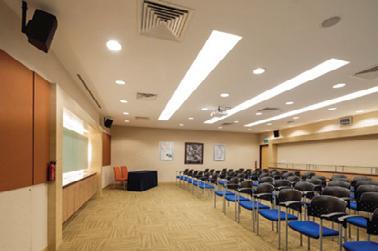

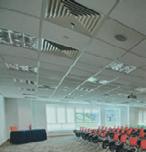

FUNCTION ROOM STAR ANISE SEMINAR ROOMS LAVENDER BASIL SHAW FOUNDATION ALUMNI HOUSE sfahvenues@nus.edu.sg l nus.edu.sg/alumnet/alumnihouse l +65 6516 7700 80% Discount NUS Alumni & Student Groups 50% Discount Government Agencies 20% Discount NUS Alumni Organise events and meetings at Shaw Foundation Alumni House (SFAH). SFAH venues are suitable for conferences, workshops, networking events and many other types of events. Find the best venue for your event now!
Mr Chen Hong Wei (Design and Engineering ’21)
Lai Ho Bing (Design and Engineering ’21)
Tan De Jun (Design and Engineering ’22)
the “Pro” in Pro Bono Adjunct Professor
Lee Yen Kee (Law ’85)
Elaine Ho Lynn-Ee (Arts and Social Sciences

18 FOCUS Seeing the Silver Lining 26 FORUM Riding the Silver Wave 30 PURSUIT OF EXCELLENCE Catching that Fall
Mr
Mr
32 CHANGEMAKER Putting
Ruby
34 SPOTLIGHT Bridging the Gap through Dialogue 36 FRONTIERS Caring is Complicated Professor
’02) 38 SPECIAL FEATURE Celebrating an Icon 40 ALUMNI HAPPENINGS 48 PATH LESS TRAVELLED Banking on Doing Good Ms Junie Foo (Arts and Social Sciences ’90) OCT – DEC 2022 36 CONTENTS CAMPUS UPDATES 02 Health District @ Queenstown Honoured by a $5 Million Gift from the Widjaja Family 04 NUS Researchers Invent Self-charging, Ultra-thin Device that Generates Electricity from Air Moisture 06 Putting Their Best Feet Forward OAR HIGHLIGHTS 08 Celebrating Milestones and Memories 10 A Homecoming for NUS Alumni at Long Last 12 Future-ready Workshops 13 Tech Talk 14 CALENDAR OF ALUMNI EVENTS The AlumNUS is published quarterly by NUS Office of Alumni Relations. The views and opinions expressed are those of the authors and do not necessarily represent the views of NUS Office of Alumni Relations or National University of Singapore. Copyright 2022 by National University of Singapore. All rights reserved. Printed in Singapore by KHL Printing Co Pte Ltd. For more information or to read The AlumNUS online, please visit nus.edu.sg/alumnet/The AlumNUS STAY CONNECTED: OFFICE OF ALUMNI RELATIONS 11 Kent Ridge Drive #05-01 Shaw Foundation Alumni House Singapore 119244 Tel: (65) 6516-5775 Advisor MR BERNARD TOH (Architecture ’84) Senior Editor MS WENDY ONG (Arts and Social Sciences ’95) Editor MR BENJAMIN LEE Deputy Editor MS NG HUI FERN Deputy Editor MS TAN LI HUI (Arts and Social Sciences ’17) Production Assistant MS NOREEN KWAN Publishing Consultant MEDIACORP PTE LTD @nus_alumni NUS Alumni NUS Alumni Subscribe: +65 8698 5131 18 The AlumNUS clinched the following award at APEX 2022: GRAND AWARD Magazines, Journals and Tabloids – Custom Published 2022
HEALTH DISTRICT @ QUEENSTOWN HONOURED BY A $5 MILLION GIFT FROM THE WIDJAJA FAMILY
THE NATIONAL UNIVERSITY OF SINGAPORE (NUS) HAS RECEIVED A GENEROUS GIFT OF $5 MILLION FROM MR FRANKLE WIDJAJA, his wife Mrs Jehnny Widjaja and their daughter Ms Deborah Widjaja. The gift, which will be made over five years, will support initiatives under Health District @ Queenstown, a first-of-its-kind multi-stakeholder collaboration to increase healthy longevity, enable purposeful longevity, promote intergenerational bonding, and support a community for all ages.

The Housing & Development Board (HDB), National University Health System (NUHS) and NUS – along with an expanding list of partners from the public, private and social sectors – are working together to address these goals. As highlighted by the US National Academy of Medicine’s Global Roadmap for Healthy Longevity, multiple systems within society will need to be activated, transformed and coordinated to address all aspects of life.
The gift was presented by the Widjajas to NUS President Professor
Tan Eng Chye (Science ’85), and NUS Senior Vice President (Health Innovation & Translation) and NUHS Senior Advisor Professor John Eu-Li Wong (Medicine ’81).
Prof Wong said, “This philanthropic gift, in support of the Health District @ Queenstown, will go towards scalable and sustainable initiatives that address the multiple determinants of health to improve physical, mental and social well-being, strengthen intergenerational cohesion, and develop a community for all ages. We are deeply grateful to Mr Frankle Widjaja, Mrs Jehnny Widjaja and Ms Deborah Widjaja for their
CAMPUS UPDATES
(left to right) Ms Deborah Widjaja, Mrs Jehnny Widjaja and Mr Frankle Widjaja presenting the cheque to NUS President Prof Tan Eng Chye as well as NUS Senior Vice President (Health Innovation & Translation) and NUHS Senior Advisor Prof John Eu-Li Wong.
2 . THE ALUM NUS
generosity and unwavering support, and for sharing our commitment to benefit the community around us. We are truly inspired by the support from not only the Widjaja family but the whole of Singapore, and this gift is yet another demonstration of how individuals can uplift the community.”
Mr Widjaja, who is the Executive Chairman and Chief Executive Officer for Bund Center Investment Limited, and Chairman of Shanghai Golden Bund Real Estate Co. Limited, said, “It has always been a key priority for my family and I to support whole-of-society initiatives – such as the Health District @ Queenstown – that could bring about transformative changes in the community and society. I am confident that the positive impact of this initiative will benefit communities beyond Singapore, and we are excited to lend our support to this meaningful endeavour.”
Noting that the recent global events have shown that things cannot be taken for granted, Ms Widjaja emphasised the need to be future-ready. She said, “Being future-ready means being proactive and creating a better future. The Health District @ Queenstown is testament to this as it encourages one to

This article was
8
Mr Frankle Widjaja
look outward and forward. We are the change that we seek. The strength of individuals across all ages, working together – now that makes a change.”
“Today’s decision-makers are investing in young people because they are convinced that it will provide the longest and most effective dividend towards meeting future goals. I hope our young people continue to be civic-minded and play an active role in shaping our future,” added Mrs Widjaja.
CO-CREATING A HEALTHY TOWN FOR ALL
Health District @ Queenstown aims to increase healthy longevity, enable purposeful longevity, promote intergenerational bonding and support a community for all ages. It will focus on four key areas to achieve its objectives:
1. Preventive Health and Care Delivery: Encouraging the uptake of preventive health recommendations and the shifting of care delivery from hospital to, or near residents’ homes.
2. Purposeful Longevity: Enabling purposeful longevity by providing opportunities for residents to work, volunteer and participate in lifelong learning.
3. Planning and Design: Implementing planning and design solutions to support ageing in place, social and mental well-being, and for an active lifestyle.
4. Technology: Co-designing affordable technological solutions with the community to improve residents’ lives.
(left to right) Ms Deborah Widjaja, Mrs Jehnny Widjaja, Mr Frankle Widjaja, NUS President Prof Tan Eng Chye, HDB Deputy CEO (Building) Dr Johnny Wong, and NUS Senior Vice President (Health Innovation & Translation) and NUHS Senior Advisor Prof John Eu-Li Wong.
first published on
August 2022 on NUS News at news.nus.edu.sg/health-district-queenstown-honoured-by-5-million-gift-from-the-widjaja-family.
OCT—DEC 2022 3
NUS researchers invent self-charging, ultra-thin device that generates electricity from air moisture
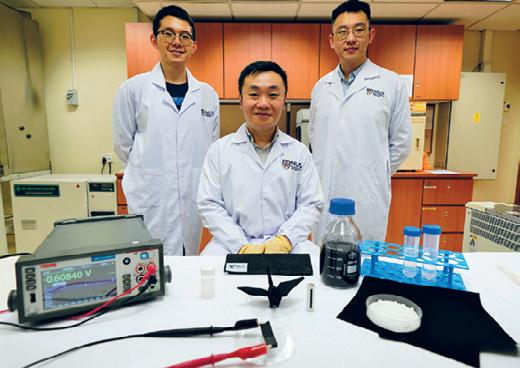
IMAGINE BEING ABLE TO GENERATE ELECTRICITY
BY HARNESSING MOISTURE IN THE AIR AROUND YOU WITH JUST EVERYDAY ITEMS LIKE SEA SALT AND A PIECE OF FABRIC, or even powering everyday electronics with a non-toxic battery that is as thin as paper. A team of researchers from the College of Design and Engineering (CDE) has developed a new moisture-driven electricity generation (MEG) device made of a thin layer of fabric — about 0.3 millimetres (mm) in thickness — sea salt, carbon ink and a special water-absorbing gel.
The concept of MEG devices is built upon the ability of different materials to generate electricity from the interaction with moisture in the air. This area has been receiving growing interest due to its potential for a wide range of real-world applications, including self-powered devices such as wearable electronics like health monitors, electronic skin sensors, and information storage devices.
Key challenges of current MEG technologies include water saturation of the device when exposed to ambient humidity and unsatisfactory electrical performance. Thus, the electricity generated by conventional MEG devices is insufficient to power electrical devices and is also not sustainable.
To overcome these challenges, a research team led by Assistant Professor Tan Swee Ching (Science ’01) from the Department of Materials Science and Engineering under CDE devised a novel MEG device containing two regions of different properties to perpetually maintain
a difference in water content across the regions to generate electricity and allow for electrical output for hundreds of hours. This technological breakthrough was published in the print version of scientific journal Advanced Materials on 26 May 2022.
fabric made of wood pulp and polyester.
One region of the fabric is coated with a hygroscopic ionic hydrogel, and this region is known as the wet region. Made using sea salt, the special water-absorbing gel can absorb more than six times its original weight, and it is used to harvest moisture from the air.
The NUS team’s MEG device consists of a thin layer of fabric which was coated with carbon nanoparticles. In their study, the team used a commercially-available
“Sea salt was chosen as the waterabsorbing compound due to its non-toxic properties and its potential to provide a sustainable option for desalination plants to dispose of the generated sea salt and brine,” shared Asst Prof Tan.
CAMPUS UPDATES
Asst Prof Tan Swee Ching (Science ’01) (centre), together with Dr Zhang Yaoxin (Engineering ’20) (left) and Mr Qu Hao (right), developed a self-charging fabric that generates electricity from air moisture.
4 . THE ALUM NUS
The other end of the fabric is the dry region which does not contain a hygroscopic ionic hydrogel layer. This is to ensure that this region is kept dry and water is confined to the wet region.
Once the MEG device is assembled, electricity is generated when the ions of sea salt are separated as water is absorbed in the wet region. Free ions with a positive charge (cations) are absorbed by the carbon nanoparticles which are negatively charged. This causes changes to the surface of the fabric, generating an electric field across it. These changes to the surface also give the fabric the ability to store electricity for use later.
Using a unique design of wet-dry regions, NUS researchers were able to maintain high water content in the wet region and low water content in the dry region. This will sustain electrical output even when the wet region is saturated with water. After being left in an open humid environment for 30 days, water was still maintained in the wet region, demonstrating the effectiveness of the device in sustaining electrical output.
“With this unique asymmetric structure, the electric performance of our MEG device is significantly improved in comparison to prior MEG technologies, thus making it possible to power many common electronic devices, such as health monitors and wearable electronics,” explained Asst Prof Tan.
The team’s MEG device also demonstrated high flexibility and was able to withstand stress from twisting, rolling and bending. Interestingly, its outstanding flexibility was shown by the researchers by folding the fabric into an origami crane which did not affect the overall electrical performance of the device.
The MEG device has immediate applications due to its ease of scalability and commercially-available raw materials. One of the most immediate applications
The new moisture-driven electricity generation device invented by NUS researchers capitalises on the difference in moisture content of the wet and dry regions of the carbon-coated fabric to create an electric current. Sea salt is used as a moisture absorbent for the wet region.

is for use as a portable power source for mobile powering electronics directly by ambient humidity.
“After water absorption, one piece of power-generating fabric that is 1.5 by 2 centimetres in size can provide up to 0.7 volts (V) of electricity for over 150 hours under a constant environment,” said research team member Dr Zhang Yaoxin (Engineering ’20).
The team has also successfully demonstrated the scalability of its new device in generating electricity for different applications. The NUS team connected three pieces of the power-generating fabric together and placed them into a 3D-printed case that was the size of a standard AA battery. The voltage of the assembled device was tested to reach as high as 1.96V – higher than a commercial AA
battery of about 1.5V – which is enough to power small electronic devices such as an alarm clock.
The scalability of the NUS invention, the convenience of obtaining commercially available raw materials as well as the low fabrication cost of about $0.15 per metre square make the MEG device suitable for mass production. “Our device shows excellent scalability at a low fabrication cost. Compared to other MEG structures and devices, our invention is simpler and easier for scaling-up integrations and connections. We believe it holds vast promise for commercialisation,” shared Asst Prof Tan.
The researchers have filed a patent for the technology and are planning to explore potential commercialisation strategies for real-world applications.
This article was first published on 17 August 2022 on NUS News at news.nus.edu.sg/self-charging-ultra-thin-device-that-generates-electricity-from-air-moisture
Asst Prof Tan Swee Ching
OCT—DEC 2022 5
PUTTING THEIR BEST FEET FORWARD
THE MORNING OF SATURDAY, 3 SEPTEMBER, DAWNED BRIGHT AND CHEERY, after two weeks of heavy rain. Mr Leonard Tan (Engineering ’18) heaved a sigh of relief. “I’m glad it will go according to plan,” he said, referring to the Raffles Hall Association (RHA) alumni community’s involvement in “Ready, Set, Gold” for NUS Cares 2022. The charity walk was organised by Blossom Seeds, a group that supports lonely and needy seniors by promoting integration and friendships.
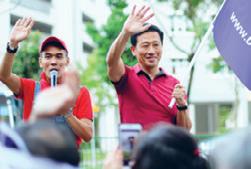
Both undergraduates and alumni stepped up to support the event by befriending wheelchair-bound seniors and accompanying them on a 1.5km walk through the Canberra estate. They were joined by Minister for
The event saw a great show of camaraderie by the RHA alumni.
Health Mr Ong Ye Kung and Professor Chen Tsuhan, Deputy President (Research and Technology) and Distinguished Professor. In all, the NUS contingent comprised 15 students, nine alumni and three staff. They were part of a wider community of 1,500 walkers from over 30 organisations, among them Canberra Secondary School, Sembawang God of Wealth Temple, the Buddhist Fellowship, People’s Association, Council for Third Age and Health Promotion Board (HPB). After the walk, participants also enjoyed a carnival that featured a number of games and challenges centred on healthy living.
with them. While spending time with these seniors is no substitute for family time, I am happy for the chance to get to know them better and forge a meaningful connection.”
Such a connection was valuable for the senior she walked with, 78-year-old Mdm Alice Kong. Mdm Kong lives alone in Canberra and does not have a chance to go out very much because of medical conditions that have left her wheelchair-bound.
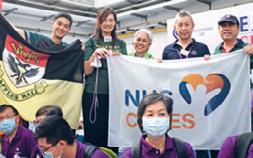
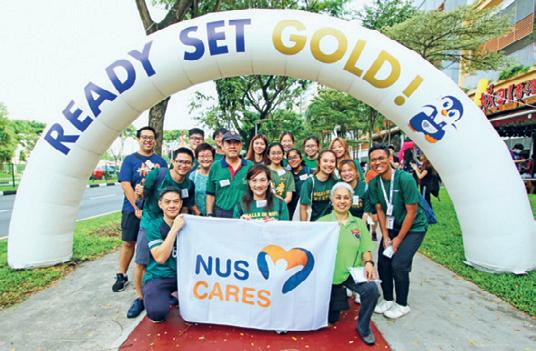
“I love to be around young people and the young at heart, so I am grateful for them taking the time out to be with me on a Saturday morning,” she shared. Mdm Kong was visibly excited as she waited for Minister Ong to flag off the morning’s walk. When she returned to the starting point, she told The AlumNUS that being among the crowds and seeing the bustle of the neighbourhood was an unforgettableMr Ong Ye Kung (right) flagging off the charity walk.
It was a meaningful morning for all involved, especially Ms Teo Yee Hua, a current student at the School of Computing. “I am from Malaysia and all my family is back home. I haven’t had a chance to see much of them because of the pandemic, so I really miss interacting
CAMPUS UPDATES
Alumni and undergraduates proudly displaying the NUS Cares banner at the event.
6 . THE ALUM NUS
Photos: Hong Chee Yan
sight. “We don’t often get to see the community out and about,” she said.
Mr Tan was instrumental in securing RHA’s participation in the event. “Over the years, I’ve tried to give back on different fronts: from befriending seniors to accompanying them on their medical appointments,” shared the 29-yearold financial advisor. Regularly finding different ways to give back is as easy as refreshing the Giving.sg page every month, he added with a laugh. He is no stranger to providing RHA members opportunities to give back, with previous efforts supporting soup kitchens and
senior activity centres. “Giving back is a joy and I am happy to share that joy with fellow alumni and present students,” he said, adding that he worked closely with fellow alumnus and RHA Chairperson

Ms Lim Swee Kim (Computing ’88) to make the event a reality.

The pair have collaborated closely on various charity projects for the RHA community, even during the pandemic. To mark NUS Day of Service in 2021, they rallied six volunteers to prepare meals for over 10,000 beneficiaries at Willing Hearts, a soup kitchen that prepares, cooks and distributes about 10,000 daily meals to over 70 locations islandwide.

FIND YOUR LANE
Whether your passion is to aid the disadvantaged, champion environmental causes or be a steward for animal welfare, there are plenty of ways to give back. You don’t have to do it alone: join fellow alumni and the NUS community in making a difference and start giving back today!

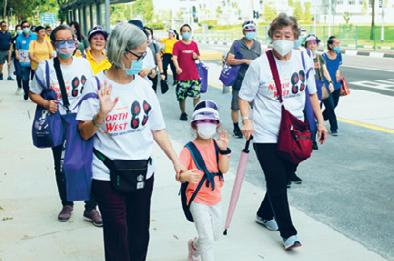
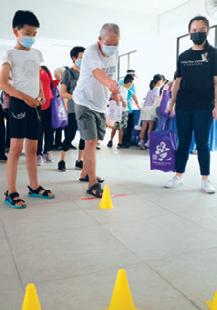
Visit nus.edu.sg/alumnet/ events/NUSCares for details.
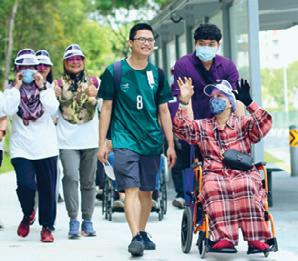 Participants enjoyed fun and games at the carnival held after the walk.
The volunteers paired up with children from needy families and accompanied them at the carnival.
The volunteers made sure that everyone — both young and old — was able to participate in the walk.
Participants enjoyed fun and games at the carnival held after the walk.
The volunteers paired up with children from needy families and accompanied them at the carnival.
The volunteers made sure that everyone — both young and old — was able to participate in the walk.
OCT—DEC 2022 7
Celebrating Milestones and Memories
DECKED OUT IN THEIR GROOVIEST DIGS, CLOSE TO 800 ALUMNI RETURNED TO NUS’ BUKIT TIMAH CAMPUS ON 2 JULY FOR A DISCO FIESTA FULL OF FUN, LAUGHTER AND JOYFUL REMINISCENCE. Organised by NUS Alumni Relations and co-hosted by NUS Law and the Lee Kuan Yew School of Public Policy (LKYSPP), this year’s Bukit Timah Homecoming was graced by Guest-of-Honour, NUS Chancellor President Halimah Yacob (Law ’78).
The evening’s programme brought alumni down memory lane with lively performances of nostalgic 1970s disco hits by the University’s musical talents, Raffles Hall Family and Friends, NUS Alumni Sing-Along, and Silver Jam. Amid the reunions and catch-ups, one of the evening’s highlights was when a group of gorgeous NUS Senior Alumni strutted the runway dressed in glittering creations by local designers.
The homecoming event also took on an additional significance due to the combined celebrations of three milestone anniversaries –the 70th anniversary of Dunearn Road Hostels, 65th anniversary of NUS Faculty of Law and 50th anniversary of NUS Class of 1972.
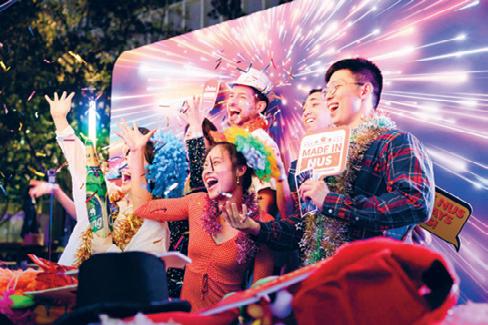
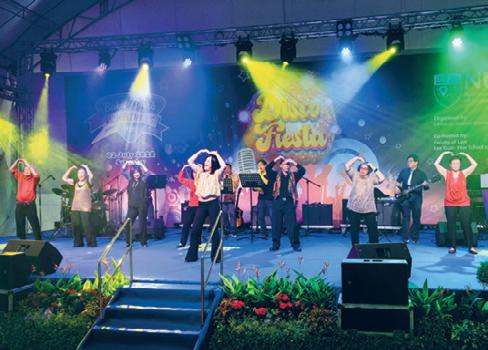
Located just a short walk from NUS’ Bukit Timah Campus, Dunearn Road Hostels (DRH)
In his address at Bukit Timah Homecoming 2022, NUS President Prof Tan Eng Chye expressed his appreciation to NUS’ alumni community for continuing to give back to the University.
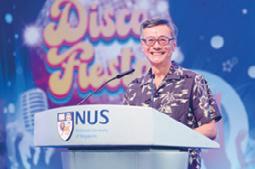
OAR HIGHLIGHTS
Members of NUS Alumni Sing-Along led the audience in a rousing group rendition of popular 70s tune ‘Y.M.C.A.’.
The photobooth was a great hit with alumni.
8 . THE ALUM NUS
opened in 1952 to provide accommodation for overseas undergraduates of the thenUniversity of Malaya. Luminaries such as former President of Singapore, the late Mr S. R. Nathan (Arts ’54), once stayed at DRH. DRH was renamed Sheares Hall in 1982 when it was relocated to NUS Kent Ridge Campus. The site housing the former DRH has since been converted to College Green, a hostel for LKYSPP graduate students.
The roots of NUS Faculty of Law lie in the establishment of the Department of Law in the then-University of Malaya in 1956. The pioneer class of law students graduated in 1961, counting among its most illustrious members Emeritus Professor Tommy Koh, Singapore’s Ambassador-at-Large and former Dean, former Chief Justice Chan Sek Keong, former Dean Thio Su-Mien, and Emeritus Professor Koh Kheng Lian.
The NUS Class of 1972 is a notable cohort that called the Bukit Timah Campus home, and the prominent alumni in this cohort continue to give back to the NUS community, 50 years after their graduation. In 2005, the Class of 1972 Bursary Fund was established to award bursaries to needy undergraduate students at NUS. As part of its 50th Anniversary celebrations, the Class of 1972 raised more than $470,000 to bring total Bursary funds to over $2 million in 2022.
Mr David Ho, an alumnus from the Class of 1972 involved in fundraising efforts for the Bursary, said: “As the first NUS alumni
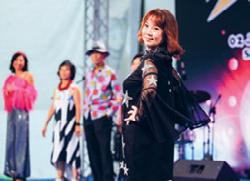
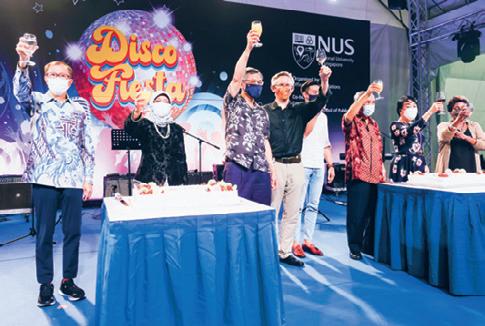
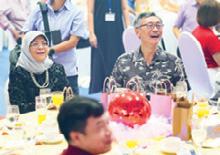
Alumni took part in an entertaining Bingo session for a chance to win prizes.

cohort to form a bursary fund, we hope our efforts will encourage other NUS alumni cohorts to pay it forward and start their own fundraising initiatives as well. Education is the best platform for levelling the playing field and ensuring everyone has a good start in life regardless of their family background and financial status. The Class of 1972 is humbled to play a small but significant part in this direction.”
In his speech at the event, NUS President Professor Tan Eng Chye (Science ’85) also recognised the role of alumni in strengthening the NUS community. “As generations of graduates return here to celebrate, I would like to thank the alumni for their continued and invaluable contributions,” said Prof Tan.
“The alumni-alma mater relationship is a lifelong one, and I am proud of how our alumni are helping to build a richer, stronger NUS community, as evidenced in the numerous alumni-led initiatives, projects and events,” he added.
NUS Chancellor President Halimah Yacob and NUS President Prof Tan Eng Chye enjoying the evening’s programme at Bukit Timah Homecoming 2022.
Our fashionable alumni took to the stage for a dazzling catwalk and dance performance.
From left: NUS Senior Deputy President and Provost Prof Ho Teck Hua (Engineering ‘85), NUS Chancellor President Halimah Yacob, NUS President Prof Tan Eng Chye (Science ’85), and Dean of NUS Faculty of Law Prof Simon Chesterman, joined alumni on stage for a celebratory toast and cake-cutting ceremony to mark the three milestone anniversaries.
OCT—DEC 2022 9
A HOMECOMING FOR NUS ALUMNI AT LONG LAST

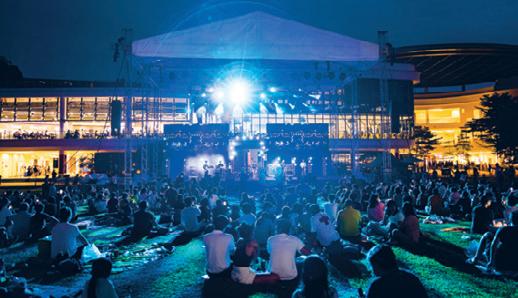
IT WAS HOMECOMING AT LONG LAST FOR ALUMNI WHO GATHERED IN-PERSON, TOGETHER WITH THEIR FAMILIES AS WELL AS STUDENTS AND STAFF, AT THIS YEAR’S KENT RIDGE ALUMNI FAMILY DAY


ON 13 AUGUST. After two years of virtual reunions, the event welcomed over 1,500 attendees for live performances by alumni and student talents at a carnival held at Town Green in NUS University Town (UTown). Organised by NUS Alumni Relations, the event also featured workshops, webinars and lab tours.
The day took off with two engaging webinars, starting with “It Takes Guts!”, where the cofounders of Curated Culture, Ms Shermaine Heng (Science, ’20) and Ms Sew Shu Wen (Science, ’20) recounted their entrepreneurial journey. They shared insights of how they launched the beverage
A great night of live performances at the carnival held on Town Green.
start-up which makes zero-sugar probiotic cold brew teas. During “What isn’t the Metaverse?”, Dr Lu Weiquan (Computing ’08), Senior Lecturer at NUS School of Computing, demystified the hype on how the Metaverse will revolutionise the way we work, play, live and learn.
OAR HIGHLIGHTS
Family fun in the sun!
Hanging out with mascots on UTown Green.
Copies of The AlumNUS were quickly snapped up by event participants.
10 . THE ALUM NUS
Alumni and their family and friends had a great time playing games such as Human Jenga.
Professor Tan Eng Chye, NUS President

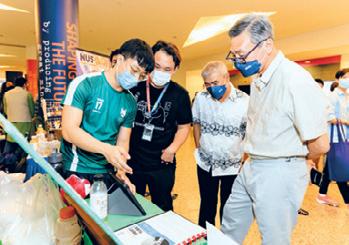
Around UTown, various NUS departments, alumni and student groups set up exciting and interactive booths, welcoming participants to take part in staged crime scene investigations, rock climbing, balloon-sculpting and having their holographic photos taken. Six busloads of participants also joined guides from the College of Design and Engineering on a rare insider tour of laboratories with an exclusive view of their latest technologies.
Those preferring to take it easy relaxed on Town Green with family and friends; and enjoyed enthralling live music and dance performances by NUS Indian Instrumental Ensemble, NUS Chinese Dance, Imprompt-3, Kameleonjazz, Sheares Hall Band and Sheares Geyao.

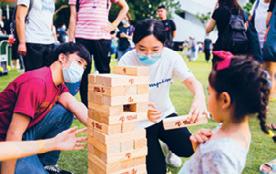
NUS President Professor Tan Eng Chye (Science ’85) welcomed everybody back to campus for the University’s biggest annual homecoming event. Prof Tan also officially announced the rebranding of NUS Day of Service to NUS Cares – a year-long, universitywide movement encouraging everyone to make a difference and give back to the wider community in Singapore. He encouraged everyone present to join in the movement by taking part in meaningful initiatives for society.
As the sun dipped below the horizon, participants laid out their picnic mats, grabbed their snacks and drinks, and settled down for a screening of Disney’s Encanto, winding down the day with their loved ones.
 NUS Cares is officially launched.
Prof Tan congratulated Sheares Hall and Yong Siew Toh Conservatory of Music on their 40th and 20th anniversaries respectively.
Participants trying their hand at various activities presented by clubs and societies at the Student Life Fair.
Prof Tan and Mr Bernard Toh (Architecture ’84), Director of NUS Alumni Relations, at one of the booths set up at UTown.
NUS Cares is officially launched.
Prof Tan congratulated Sheares Hall and Yong Siew Toh Conservatory of Music on their 40th and 20th anniversaries respectively.
Participants trying their hand at various activities presented by clubs and societies at the Student Life Fair.
Prof Tan and Mr Bernard Toh (Architecture ’84), Director of NUS Alumni Relations, at one of the booths set up at UTown.
OCT—DEC 2022 11
The Future






EARLIER THIS YEAR, THE MINISTRY OF HEALTH ANNOUNCED THE HEALTHIER




SG INITIATIVE, to manage the challenges of Singapore’s ageing population and improve health outcomes. Some 220 attendees joined us online and in person to learn how NUS is preparing health practitioners to achieve Healthier SG goals.
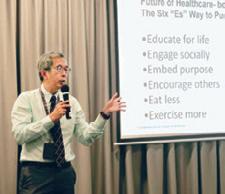
Associate Professor Lau Tang Ching (Medicine ’91), Vice Dean (Education), Yong Loo Lin School of Medicine, NUS, and Senior Consultant, Division of Rheumatology, Department of Medicine, National University Hospital, shed light on the importance of promoting health and preventing chronic illnesses, understanding the social determinants of health, and using technology and health informatics as enablers for health practitioners.
Following his riveting sharing session, Prof Lau answered various questions from audience members, ranging from how to encourage our youth to pursue a career in the medical field and how service design and design thinking can
help shape the patient experience and the healthcare landscape in Singapore, to measuring the effectiveness of government grants for senior mobility and a better quality of life, among others.


fter accidentally running over a goat with their father’s truck, two teenage siblings with incompatible personalities begin an adventure of reconciliation.
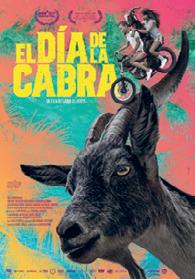


repair the truck before the tourists who will be staying at the family’s hotel arrive. On their way, they will go on a 24-hour adventure through the imaginary town of Port Paradise (inspired by the Colombian Caribbean Island of Providencia).

OAR HIGHLIGHTS
Assoc Prof Lau Tang Ching sharing more
Auditorium, Shaw Foundation Alumni House 27 October 2022 Thursday, 7.30pm - 9.10pm A FILM BY SAMIR OLIVEROS A
TECHNOLOGY AND SOCIETY –INDUSTRY OUTLOOK FOR 2030




THE UNITED NATIONS’ SUSTAINABLE DEVELOPMENT GOALS (SDGS) PROVIDE a blueprint for people, the planet, and prosperity, and are intended to be achieved by 2030. With only eight years to 2030,




a deeper, faster, and more ambitious response is needed.
Dr Ganesh Neelakanta Iyer (Engineering ’09), Lecturer, Department of Computer Science, NUS School of Computing, provided 110 participants

with insights on the key technologies that will help accelerate digitisation and drive our efforts to deliver the UN SDGs. He also shared more about the trends in technology that will lead us towards a socially, environmentally, and economically resilient future, as well as the impact of the UN SDGs on technology in various areas.
Dr Ganesh was then joined by moderator
Dr Amirhassan Monajemi, Senior Lecturer (Educator Track), Department of Computer Science, NUS School of Computing, as they answered some burning questions from the online audience. The questions included clarifications about the blockchain, views on ethical and sustainable energy technology, and the available job opportunities that come with enabling technologies.
!
Dr Ganesh and Dr Amirhassan sharing their thoughts on participants’ questions at the Tech Talk held on 16 August 2022.
TECH TAL
SLEEP IN CHILDREN AND ADOLESCENTSWHAT EVERY PARENT NEEDS TO KNOW Office of Alumni Relations School of Continuing and Lifelong Education Thursday 7.30pm - 9.00pm (Medicine ‘88) Associate Professor, Department of Paediatrics, Yong Loo Lin School of Medicine, National University of Singapore Senior Consultant, Division of Paediatric Pulmonary Medicine and Sleep Assistant Professor, Department of Paediatrics, Yong Loo Lin School of Medicine, National University of Singapore Senior Consultant, Division of Paediatric Pulmonary Medicine and Sleep Assistant Professor, Department of Paediatrics, Yong Loo Lin School of Medicine, National University of Singapore Head & Senior Consultant, Division of Paediatric Pulmonary Medicine and Sleep Register at
OCT 27
Sleep in Children and Adolescents –What Every Parent Needs to Know
Health & Wellness

Speakers:
Associate Professor, Department of Paediatrics, NUS Medicine; Senior Consultant, Division of Paediatric Pulmonary Medicine and Sleep, Department of Paediatrics, Khoo Teck Puat – National University Children’s Medical Institute, NUH
Assistant Professor, Department of Paediatrics, NUS Medicine; Senior Consultant, Division of Paediatric Pulmonary Medicine and Sleep, Department of Paediatrics, Khoo Teck Puat – National University Children’s Medical Institute, NUH
Assistant Professor, Department of Paediatrics, NUS Medicine; Head and Senior Consultant, Division of Paediatric Pulmonary Medicine and Sleep, Department of Paediatrics, Khoo Teck Puat – National University Children’s Medical Institute, NUH


Feature Films (Colombian)

After accidentally running over a goat with their father’s truck, two teenage siblings with incompatible personalities begin an adventure of reconciliation. Corn and Rita must

the tourists who will be staying at the family’s hotel arrive. On their way, they go on a 24-hour adventure through Port Paradise, Colombia.
We spend a third of our lives sleeping (even more so for the young), yet we don’t spend enough time understanding and learning about sleep and its problems. Join
Dr Daniel Goh, Dr Michael Lim and Dr Mahesh Babu Ramamurthy from Khoo Teck Puat - National University Children’s Medical Institute, who will share tips for parents and caregivers on:
• Identifying when sleep is abnormal in your child;
• Understanding the importance of sleep in children;
• When and where to seek help for your child’s sleep problems; and
• Basic strategies to ensure a good night’s sleep for your child.
6 OCT Online




Thu, 7.30pm - 9.00pm
Register: alum.events/HWoct22
Contact: Ms Tan Li Hui lhtan@nus.edu.sg
(PG13)
27 Oct (Thu)
Shaw Foundation Alumni House
7.30pm 9.10pm
Register: alum.events/FFoct22
Contact: Ms Chu Hoi Yee hychu@nus.edu.sg
DECEMBER
Thirsty Thursdays
Join us for a night that goes beyond the business card exchange. Come to network, mingle, mix and enjoy drinks and appetisers. Take the opportunity to connect and reconnect with one another.
1 DEC Venue to be advised Thu, 7.30pm - 9.00pm

Register: alum.events/TTdec22
Contact: Ms Chu Hoi Yee hychu@nus.edu.sg
14 . THE ALUM NUS OCTOBER CALENDAR OF ALUMNI EVENTS OCT.NOV.DEC EN nus.edu.sg/alumnet/events
Information is correct at the time of publication and is subject to change without prior notice.
the adventure going with us as we meaningfully engage
inspire our alumni,



continue

transformative

Keep
and
and
the
NUS journey. Story Tellers, Content Creators, Information Specialists ... | Join us at NUS Office of Alumni Relations. WE ARE HIRING APPLY NOW
helping hand

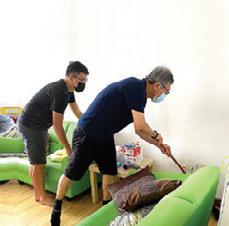
lead volunteers

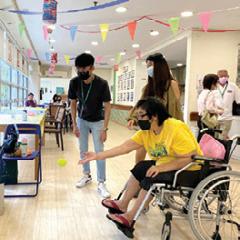
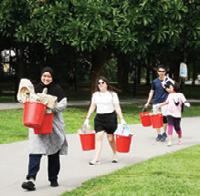
difference
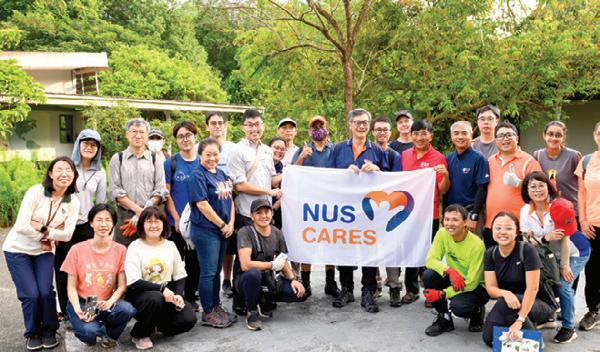
Extend your
to give back to society, under the umbrella of NUS Cares. You can
to serve in ways ranging from providing meals to improving the environment. Spearhead an activity with your friends, fellow alumni and the rest of the NUS Community. Make a
today by championing an activity in any of these areas: We can help you get started. Find out more now! NUS Cares #NUSCares • Animal welfare • Arts and heritage • Children and youth • Community • Education • Elderly • Environment • Special needs • Sports
NUS Bursary#
up Government Bursary


full coverage of

S$1,000)
S$4,000
annum



S$690)
Enhancement Grant



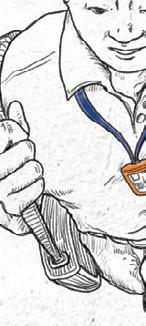


S$10,000 over 4 years
up financial aid for on-campus stay and overseas





S$690)
Enhanced Financial Aid








Read more about the
Scheme here:
tops
to provide
tuition fees (PCI* ≤
provides
per
of living expenses (PCI* ≤
Opportunity
# provides
to top
programmes (PCI* ≤
www.facebook.com/NUS.Giving www.nus.edu.sg/nusgiving askdvo@nus.edu.sg 1800-DEVELOP (1800-338-3567) GIVE ONLINE NUS SECURED ONLINE DONATION PORTAL Please check that the QR code leads you to a webpage with a URL that starts with “bbis.nus.edu.sg” and a padlock icon. PAYNOW 1. Launch your mobile banking application 2. Tap on “Scan & Pay” and scan the PayNow QR code 3. Key in the gift amount 4. Under the UEN/Bill Reference Number, key in <DA019-NRIC/FIN/UEN> to enjoy tax deduction 5. Please verify that the auto-populated text under “Recipient” is “National University of Singapore” in full. Every student is a Enable them to complete their education journeys. * Per Capita Income # In addition to financial aid in the form of bursaries, grants, loans and more for all eligible full-time undergraduates Information retrieved from National University of Singapore (NUS) News
DID YOU KNOW?
According to a study published in The Lancet in 2018, Singaporeans will have an average life span of 85.4
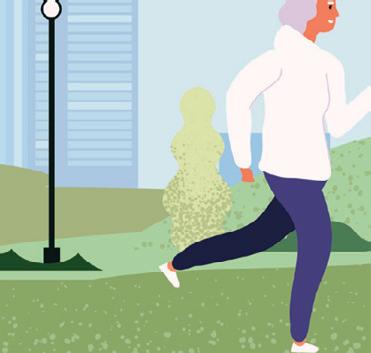
YEARS in 2040, the third-longest globally next to Spain and Japan.
SEEING THE


SILVER LINING
CALL IT WHAT YOU WANT — THE THIRD AGE, THE SILVER TSUNAMI OR THE LONGEVITY BOOM — but there is no escaping the fact that the world’s population is getting older. Decades of steadily rising life expectancy and declining birth rates have got us to this point, especially in Singapore, which has one of the fastest-ageing populations in the world. By 2030, all ‘baby boomers’ (those born in the post-war period between 1946 and 1964) will enter the ‘65 and older’ age group, and government statistics project that they will make up 23.8 per cent of Singapore’s citizen population — up from 17.6 per cent in 2021.
To put it another way, about one in four Singaporeans will be 65 years old and above by 2030. This realisation has caused much handwringing and debate over a host of issues. Among these include the potential ramifications

on individual health as well as the public healthcare system, the adequacy of social support and protection for older people, strategies to enhance their livelihoods and productive capacity, and how living spaces can be re-designed or new technologies developed to help seniors live independently for longer.
Not ones to shy away from a challenge, NUS’ faculty, students and alumni are addressing these issues head on, and from multiple dimensions.
AT THE CELLULAR LEVEL
Any thoughtful discussion on ageing should distinguish between life expectancy — the average number of years a person can expect to live — and healthy life expectancy, defined as the average number of years a person can expect to live in good health, free of physical functional limitations.
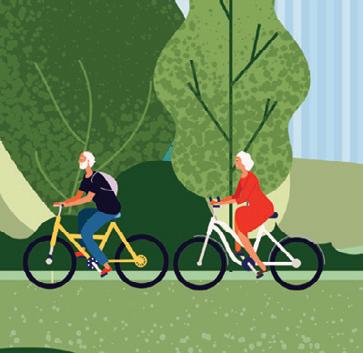

FOCUS
18 . THE ALUM NUS
We are all getting older and there is nothing we can do about it — or is there? One-dimensional thinking posits ageing purely in terms of deteriorating health or as a burden to society. In helping Singapore prepare for an ageing population, NUS wants older adults to enjoy long, healthy, happy and productive lives.
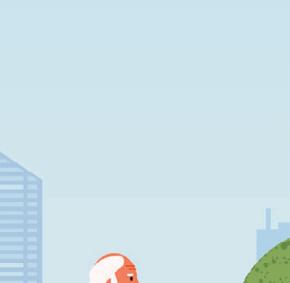 TEXT BY WANDA TAN
TEXT BY WANDA TAN
In a 2019 report by the Ministry of Health (MOH) and the United States-based Institute for Health Metrics and Evaluation (IHME), researchers made this distinction while studying the burden of disease in Singapore from 1990 to 2017 (see table). An increasing trend was found for both metrics: however, although Singaporeans are now living longer, they are spending a greater proportion of that time in ill-health due to chronic disease or injury.
The big question, then, is how to increase life expectancy and simultaneously reduce the amount of time people spend in poor health. At the National University Health System’s (NUHS) Centre for Healthy Longevity, various research projects are ongoing to develop and test interventions that can delay the ageing process — to be specific, one’s biological age, measured by
the extent of damage to the body’s cells, tissues and organs over time. This parameter takes into account not just how long a person has been alive (chronological age) but also other factors such as genetics, lifestyle and nutrition. The sooner we know our biological age, the sooner we can intervene to delay or prevent the onset of chronic diseases such as diabetes, hypertension and heart disease.
Professor Brian Kennedy, the Centre’s Director, heads the Healthy Longevity Translational Research Programme at NUS Yong Loo Lin School of Medicine, where scientists and clinicians are investigating different aspects of the biology of ageing — for example, systemic ageing, vascular ageing, or brain ageing — to identify pathways for intervention. Other studies involving human subjects aim to, for instance, test the use of novel biomarkers of ageing in hospitals, or assess the effectiveness of different types of exercises and nutritional supplements in lowering the biological age of certain population groups.
“Chronic diseases are hard to completely reverse. If people manage them, they will live longer. But if we can slow ageing, they won’t get the diseases in the first place,” Prof Kennedy told CNA in June 2022 as part of NUS’ documentary series, Innovating for the Future. “The middle-aged population is at [highest] risk of getting chronic diseases in the near future. If we can target them [through biological age testing], we can slow or reverse aspects of their ageing.”
A MATTER OF CARE
Elsewhere at NUS, the research focus is less on the biological or clinical aspects of ageing, and more on the social and psychological side. Duke-NUS Medical School’s Centre for Ageing Research and Education (CARE) is perhaps
The middle-aged population is at [highest] risk of getting chronic diseases in the near future. If we can target them [through biological age testing], we can slow or reverse aspects of their ageing.
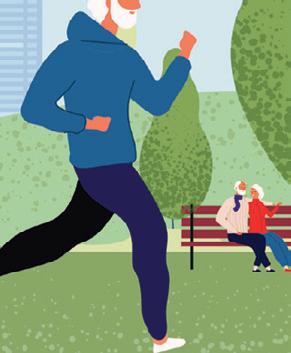

Professor Brian Kennedy, Director, Centre for Healthy Longevity, NUHS, in a June 2022 CNA interview
FINDINGS FROM THE BURDEN OF DISEASE IN SINGAPORE, 1990 – 2017
Life expectancy at birth
Healthy life expectancy at birth



Time spent in ill health
years84.8 years
years74.2 years
years10.6 years
OCT—DEC 2022 19
19902017
76.1
67.1
9.0
Source: MOH and IHME
YOU ARE WHAT YOU EAT
With greater awareness of how good nutrition can help people age well and prevent or manage chronic illness, the food science industry is booming. At Danone Specialized Nutrition, Senior Health & Science Manager
Ms Mia Isabelle (Science ’07) leads the company’s nutrition and scientific aspects of healthy ageing innovations in Southeast Asia. She reveals two exciting areas of food research:
1. MOBILITY
“Ageing causes decline in muscle, bone and joint health, which is important for movement. For example, our muscle mass starts to decline from the age of 30 and the loss accelerates after 50. At the same time, our muscles become less sensitive to protein intake. Older people can benefit from higher protein intake, and nutrients like vitamin D and leucine, to help promote muscle protein synthesis.”
2. GUT MICROBIOTA
“There is growing knowledge of the importance of our gut microbiota beyond gut health [i.e., not just to aid digestion and regulate immune function but also prevent weight gain, control blood sugar, and improve brain and heart health]. Ageing alters the gut microbiota balance, so specific probiotics and prebiotics that help restore the balance would be helpful for older populations.”
best known for its large, longitudinal, nationally-representative surveys of older adults in Singapore, including the Panel on Health and Ageing of Singaporean Elderly (PHASE) and Transitions in Health, Employment, Social Engagement and Inter-generational Transfers in Singapore (THE SIGNS). Besides these, studies on specific ageing-related themes — such as caregiver stress and health literacy among older people — have led to real policy changes. More support services for caregivers have since been established, and healthcare institutions now increasingly provide bilingual information on prescription medication labels.
“In 2021, we released a paper on how loneliness impacts health expectancy among older adults — an issue which garnered a lot of attention during the COVID-19 pandemic as many people were isolated at home,” says Dr Rahul Malhotra, Assistant Professor, Deputy Director and Head of Research at CARE, in an interview with The AlumNUS. Co-authored with experts from Japan and published in the Journal of the American Geriatrics Society, the study reported that older adults aged 60 and above who perceive themselves to be lonely are likely to die a few years earlier than their never-lonely peers. Moreover, they are likely to spend less of their remaining life in good health or without limitations when carrying out activities of daily living activities, such as bathing or feeding themselves.
This finding highlights the importance of identifying and alleviating loneliness among older adults, for instance, through regular visits or video calls with volunteer befrienders for seniors living alone. It also adds to CARE’s body of work about the impact of different health and social constructs on life and health expectancy. For example, Dr Malhotra shares, “We found that females live longer than males but spend more time in bad health. Non-
Chinese Singaporeans have a greater prevalence of chronic diseases. Those with lower educational qualifications tend to have lower health expectancy as well.”
From CARE’s research repository, another key fact stands out: “Despite the physical limitations that inevitably come with ageing, we shouldn’t be fatalistic in the perception that things will always go downhill when we get older,” says Dr Malhotra. “Our research shows heterogeneity in the ageing experience; physically, mentally and socially. In terms of social support or engagement, the usual expectation is that as you grow older, your social networks tend to shrink. But our work has found that the opposite is quite often true.”
REAPING THE LONGEVITY DIVIDEND
Assistant Professor Cynthia Chen (Science ’09) from the Saw Swee Hock School of Public Health (SSHSPH) is similarly critical of public discourse that depicts the elderly population as a giant millstone around society’s neck. “The aged population is a

In 2021, we released a paper on how loneliness impacts health expectancy among older adults — an issue which garnered a lot of attention during the COVID-19 pandemic as many people were isolated at home.
Dr Rahul Malhotra, Assistant Professor, Deputy Director and Head of Research, CARE, Duke-NUS Medical School

FOCUS
20 . THE ALUM NUS
potential well of resources which, if we properly understand and tap into, can immensely benefit our society. This goes beyond helping them to live healthier lives. It is also about utilising their life experiences and extended healthy years to continually engage society as productive members,” she says.
Indeed, the term ‘longevity dividend’ has entered the vernacular. It refers to the potential of people to contribute as they age — by remaining in the workforce and boosting organisational diversity and performance, paying taxes to support public services, serving as caregivers and volunteers, increasing gross national income through accumulated wealth, and so on.
As a statistician, Asst Prof Chen’s research covers five main areas:
1. Productivity and engagement, which measures the engagement of older persons in society, either through paid work or volunteering;
2. Well-being, which measures the health of older persons;
3. Equity, which measures the gap between the ‘haves’ and the ‘have nots’;
4. Cohesion, which measures social connectedness within and between generations; and
5. Security, which measures economic and physical security for older persons.
WHAT’S NEW
Dr Malhotra clues us in on the latest updates to CARE’s ongoing studies.
Prescription Medication Label Improvement for Singaporean Elderly (PROMISE)
“We are currently in partnership with SingHealth and the National Healthcare Group to develop locally-specific pictograms for use on medicine labels. Hopefully, these will one day be used across Singapore’s health system.” Caregiving Transitions among family Caregivers of Elderly Singaporeans (TraCE)
“We enrolled 300 caregivers and
followed up with them over time.
We are now analysing the data to identify patterns in health and well-being, employment, and other outcomes among caregivers.”
Qualitative Insights into Caregiving Transitions (Quali-T)
“We purposefully sampled and interviewed caregivers from the TraCE study to find out what drives their positive or negative perceptions of caregiving.
The aim is to develop a pilot intervention for enhancing positive caregiving experiences.”
Preliminary findings reveal that a number of issues still need to be ironed out to enable seniors’ full participation in, and contribution to, society. One area of concern is the persistent gender gap. “Gender differences tend to favour men in areas of productivity, engagement and security. It may be a difference in preferences, whereby women choose to retire earlier to spend more time with grandchildren or take career breaks to care for their children or aged parents. As such, women tend to live longer than men, with lower income and savings, and are more likely to live alone due to widowhood,”
Asst Prof Chen explains. “If we take their lower income and savings, and divide it by a longer life span, they have less resources to get through to the end of their lives. Therefore, they are at higher risk of living in poverty than men in old age. Huge income differences between genders suggest that there is room for improvement with regards to women’s paid work, job opportunities and retirement income.”
More can also be done to keep seniors meaningfully engaged in society. She adds, “Factors such as having a more flexible schedule, workplace proximity, and proper matching of their interests and skills to the tasks have been identified as important considerations by some studies. This is a twoway street, as evidence shows that continued work also benefits older adults both mentally and physically.” That said, it is important to differentiate between older adults who continue to work because they have to make ends meet, and those who are financially secure and choose to continue to work. Asst Prof Chen notes the need to identify and provide
Assistant Professor Cynthia Chen, Saw Swee Hock School of Public Health, NUS
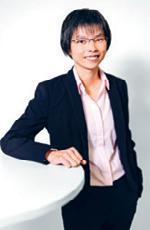
The aged population is a potential well of resources which, if we properly understand and tap into, can our society.
OCT—DEC 2022 21
Adjunct Associate Professor Ian Leong, Assistant Chairman Medical Board (Community Care Integration), Tan Tock Seng Hospital

assistance to the former group, and to also recognise the often-overlooked contributions in unpaid work such as volunteering.
Arguably, though, fixing the pain points in healthcare takes precedence. “Singapore’s conventional method for healthcare payment uses fees for service and works based on volume and treating illnesses and injuries as they occur,” says Asst Prof Chen. “This is expensive and unsustainable, as hospitals and healthcare organisations cannot expand indefinitely. Furthermore, as chronic diseases are a cumulation of lifestyle behaviours, a life course approach to understanding and preventing such diseases is necessary.” MOH’s announcement earlier this year to pursue a Healthier SG strategy — which aims to motivate all Singaporeans to proactively take steps towards better health and quality of life through preventive care — is therefore very timely.
THE CASE FOR HEALTHCARE TRANSFORMATION
Before Healthier SG, there was MOH’s Three Beyonds — the three paradigm shifts regarded as critical for the transformation of our healthcare system, in preparation for an ageing population. At Tan Tock Seng Hospital (TTSH), Adjunct Associate Professor Ian Leong (Medicine ’92), now the Assistant Chairman Medical Board (Community Care Integration), has spent the better part of his career focused on moving ‘Beyond Hospital to Community’.
“The Three Beyonds, especially ‘Beyond Hospital to Community’, represented a clarion call to all healthcare clusters for a more concerted involvement of hospital staff in the community, working alongside our community partners, to coordinate and integrate care,” says Assoc Prof Leong. “It recognised that the reality of managing chronic illness is ‘out there’ and not in the hospital.”
TTSH, for its part, has gradually stepped up its involvement in the community over the last two decades or so. Shared care between hospital specialists and polyclinic doctors is becoming the norm. In addition, TTSH runs multidisciplinary care teams comprising doctors, nurses, allied health professionals and health coaches (trained laypersons) who work in diverse community settings across the Central Singapore region. For instance, in home care, a dedicated team regularly visits patients (mostly elderly) who are frail or bedridden to provide direct medical care and to also support caregivers. Neighbourhood community health posts, usually set up within the premises of social service agencies and manned by nurses or health coaches, allow residents to easily access routine health screenings and learn how to manage chronic conditions. The hospital also partners with nursing homes to provide quality palliative care for those approaching the end of life.
Like Asst Prof Chen, Assoc Prof Leong agrees that further healthcare expansion, albeit necessary to some degree, is by itself
WHAT IS HEALTHIER SG?



































































HOW IT WORKS
From 2023, each resident may enrol with a family physician of their choice at a polyclinic or General Practitioner (GP) clinic.
The family physician will develop a personalised health plan for the resident, with regular follow-up visits to monitor adherence and discuss next steps.
The family physician will collaborate with other healthcare providers, and partner with community and social service agencies, to improve continuity of care and address the wider (non-medical) determinants of health.
THE UPSHOT



Integrated health ecosystem


Reduced chronic diseases

Lower healthcare costs

FOCUS
Studies show that healthcare services only contribute about 10 per cent to the health of a population. Psychosocial determinants of health — including residents’ social and physical environment as well as their health behaviours — are more important.
22 . THE ALUM NUS
Photo of Adjunct Associate Professor Ian Leong courtesy of Tan Tock Seng Hospital
Held at a community pavilion at Stirling Road (above), the GeronTech Showcase in April 2022 allowed students to demonstrate their prototypes at their respective booths (left) and also give slide presentations to a live audience of seniors (far left).

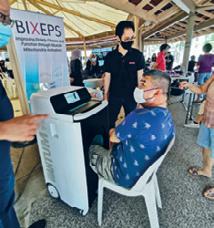
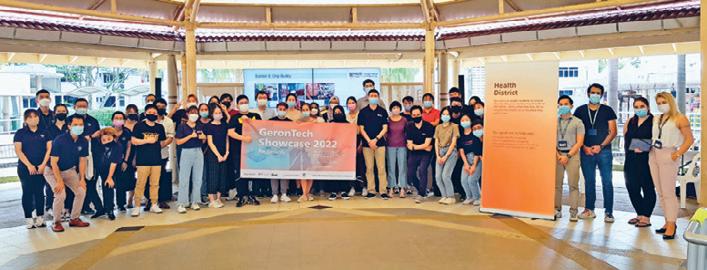
not a panacea for our greying population.
“Studies show that healthcare services only contribute about 10 per cent to the health of a population. Psychosocial determinants of health — including residents’ social and physical environment as well as their health behaviours — are more important. For example, studies estimate that residents take their medications 60 to 70 per cent of the time,” he explains.

“While there will be a continued need to address gaps for people who are unable to manage themselves, we need to think of other ways of tackling the psychosocial determinants of health. The answer to that is likely to lie beyond the medical fraternity and would require the active involvement of residents and caregivers.”
THE PROMISE OF GERONTECHNOLOGY
























































































In response to global ageing, a relatively new field called gerontechnology — a portmanteau of gerontology and technology, and first coined in the 1990s — has gained popularity.

“Gerontechnology is an interdisciplinary field that looks into the design, development and deployment of technologies to mitigate the challenges associated with ageing. These include assistive devices for mobility and rehabilitation, assistive devices for daily living – for example, automated pill dispensers, health monitoring devices for seniors, sensory aids, and technologies that assist caregivers in their caregiving,” says Dr James Kah (Engineering ’03), a Senior Lecturer at the Department of Biomedical Engineering. However, he notes, it is still nascent in Singapore. “I see big gaps in gerontechnology and assistive technology development in Singapore, since very few products that cater to these communities are developed locally to fit our local needs.”
Therefore, in 2020, Dr Kah initiated the Gerontechnology in Ageing module to introduce Biomedical Engineering students to the concept, and to equip them with knowledge and skills in this area. Using a community-based learning approach, the module includes a service-learning
OCT—DEC 2022 23
INTRODUCING…
Out of the student prototypes exhibited at the GeronTech Showcase, a few have reached or are close to reaching the end-goal of community deployment at scale. They are:
Makan Together
Adaptive tableware for the visually-impaired


Initially co-designed with and for an elderly blind man at St Luke’s ElderCare, it facilitates independent feeding through modular, customisable components; raised dots for tactile identification of individual dishes; and large slopes to scoop up food easily. To date, about 400 pieces have been distributed to social service agencies.
Grip Buddy
A hip solution to a jarring problem
Targeting seniors with weak hand strength and grip, for example, stroke survivors, it allows them to open and close the lids of jars and bottles using just one hand and the hip. It is also useful for people with upper limb disabilities. Orders have been placed by local social service agencies and it is currently being manufactured at scale.
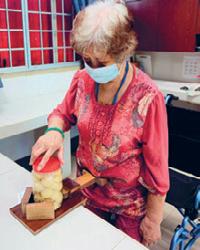
Happy Feet
An elderly-friendly dancing game
Like Dance Dance Revolution but for older adults, it encourages them to move their feet and promotes cognitive stimulation with features such as slower game speeds, larger on-screen icons and popular songs from back in the day. Play tests have been completed at a few senior care centres, and mass production is set to begin soon.

component where students work with social service agencies and the elderly to co-create innovative, affordable solutions that cater to their needs. “This high level of community engagement — where students work directly with clients in the solutioning process — allows our students to have a more direct impact on the lives of people, especially those who are disadvantaged in life due to their physical limitations. It is a powerful approach towards empathy-driven technology development,” he elaborates.
Some of the students’ prototypes were presented at a special GeronTech Showcase event held on 22 April 2022 at Stirling Road, as part of the multi-stakeholder Health District @ Queenstown pilot initiative. Organised by NUS in partnership with Lions Befrienders and the People’s Association, the event attracted about 200 residents from the neighbourhood. They visited the various booths, tested the devices on show, and gave useful feedback to the project teams for further refinement.
Among those participating in the event was 22-year-old Ms Fatin Sharafana Binte Mohd Haniff, now in the final year of her Biomedical Engineering degree. “Before taking the module last
Ms Fatin Sharafana (left, wearing black shirt) and her team debuted their Brake Bear at the GeronTech Showcase.

semester, I was aware of the potential of gerontechnology from visits to my grandmother’s. I have a close relationship with my grandmother who lives alone, and frequent visits to her place made me realise there are gaps that can be filled with gerontechnology to help older adults live independently and safely,” she says.
As the population continues to age, our society will increasingly turn to technology to address some of the associated challenges. The emerging silver economy will bring more opportunities for new technologies to be deployed with its increasingly larger user base.
Dr James Kah, Senior Lecturer, Department of Biomedical Engineering, NUS
Gerontechnologies in use (left to right): Grip Buddy; Happy Feet; and Makan Together.
FOCUS 24 . THE ALUM NUS
The course exposed Ms Fatin to a broad range of ageing-related challenges, resulting in the prototype she and her teammates developed, called Brake Bear.
Inspired by an elderly person from the Lions Befrienders’ Senior Group Home programme, Brake Bear is basically a set of wheel chocks that can be attached to any rollator for extra stability, on top of the rollator’s brakes. Elderly users can thus transfer from a standing to sitting position (and vice versa) on their rollators without the help of a caretaker, allowing them to move around on their own. “We debuted our prototype at the GeronTech Showcase and residents who tried it were impressed. When the wheel chocks were deployed, they found that the rollator stayed securely in place during a transfer. Some even expressed interest in purchasing the product!” Ms Fatin shares. Currently, her team is experimenting with different materials to improve the product’s durability, in hopes of eventually making Brake Bear commercially available.
For Dr Kah, guiding students as they seek to bring their inventions to fruition, and seeing them interact and build relationships with elderly clients beyond the projects, has been an “enriching” experience. “As the population continues to age, our society will increasingly turn to technology to address some of the associated challenges. The emerging silver economy will bring more opportunities for new technologies to be deployed with its increasingly larger user base.”
REFRAMING AGEING, IN PLACE



The intent behind gerontechnology — and, it could be said, all the work described here — is to create an environment that promotes social participation in later life and enables older adults to live independently in their own homes or within the community for as long as possible. Policymakers have dubbed this ‘ageing in place’. It is grounded in the belief that older adults have much to contribute and, with the right support, should feel
empowered to stay healthy and active in their advanced years. It runs counter to ageist attitudes and stereotypes that portray seniors as being past their prime or as sick, dependent and vulnerable individuals.
So, let us flip the narrative and celebrate getting older instead of dreading it. Let us remember that reaching a certain age is a positive achievement, for it reflects the success of modern science and healthcare, as well as one’s good fortune. Let us each play our part to help older adults live well and age gracefully. They may well be you and me one day.
FITS LIKE A GLOVE
NUS students were not the only ones who took part in the GeronTech Showcase — so did researchers like Associate Professor of Biomedical Engineering Raye Yeow (Engineering ’06), whose EsoGLOVE is a wearable, soft robotic glove used in the rehabilitation of patients with impaired hand functions, for example, stroke survivors.
In 2016, you co-founded Roceso Technologies to commercialise EsoGLOVE. Can you tell us a little bit about the device?

EsoGLOVE was officially launched in the market in 2020. Based on feedback we had gathered over the years from clinicians, therapists and patients, key features include the use of biocompatible lightweight fabric material for our soft actuation technology, a video-based feedback app to promote motor imagery, a highly-portable mini control box, and rigorous testing to meet international standards for device safety.

What has your journey in the gerontech start-up world been like? Public reception to EsoGLOVE has been great, particularly from stroke survivors who
Assoc Prof Yeow (far right, holding the EsoGLOVE) with the other co-founders of Roceso, Dr Yap Hong Kai (Engineering ’13) and Ms Jane Wang (Engineering ’16).

prefer to undergo hand rehabilitation exercises at home, rather than making trips to the hospital or rehabilitation clinic for their therapy sessions. We are seeing the growing importance of decentralised robot-assisted care at home, especially given the pandemic. The main buyers are healthcare providers and nursing homes, and we also rent it out to stroke patients for home use. Currently, EsoGLOVE is sold in more than 15 countries and used in over 50 hospitals worldwide
Where do you see the gerontechnology market going in the coming years?











I expect to see greater penetration of gerontechnologies, and this space to be a prominent area of innovation towards productive longevity. We are looking at the emergence of digital health, serious games, bespoke assistive technologies and healthcare robotics that can better support the elderly in their activities of daily living and improve their cognitive and motor health, thereby enhancing their quality of life.

OCT—DEC 2022 25
It is projected that, by 2030, 23.8 per cent of Singapore’s resident population will be aged 65 years and over. Singapore has been preparing for this since the 1980s, when a Committee on the Problems of the Aged was formed to study the implications of, and recommend responses to, an ageing population. As each cohort of seniors enjoys progressively better education, income and health, their needs and aspirations become more varied. Our alumni discuss the blind spots and challenges going forward.
Do you think Singapore is a good place to retire in?
DONALD: I came to Singapore in 1943 — during the war — and grew up here. All that I have experienced — from pain and sorrow to happiness and joy — happened here. Even though I visited many countries for my work in freight forwarding, it never crossed my mind to live in any other country. As the song goes, “this is home.”
MEE LEEN: After my official retirement from the Education Service, I went to countries such as Indonesia and Thailand to share my expertise with international schools based on my experience. I am very proud to be a Singaporean and of being able to share our internationally recognised education system. Living and working in other countries also made me appreciate Singapore more, and I’ve come to decide that this is still the best place to spend the rest of my life. ZAIBUN: Singapore is home. Everything I grew up with, from food to culture to relationships, is here. Over the years, we’ve also seen a lot of improvements in healthcare and comfort — so I wouldn’t want to relocate at this stage of my life.
SHARMA: If you had asked me 30 years ago to relocate for work, I would have said yes. But now, at past 60 years of age, my needs and wants are different. My friends and family are here. Our healthcare is not the cheapest
SINGLE-PERSON ELDERLY HOUSEHOLDS
RIDING THE SILVER WAVE
NUS alumni discuss the current state of eldercare in Singapore, and what it will take to move towards inclusive
but you are paying for high standards. I have no push factor to move anywhere else in retirement.
SHI CHUN: As a young person looking at buying a house now, the high prices make me think of retiring elsewhere, where the cost of living is lower. But one also has other considerations in old age, and access to high-quality healthcare such as that in Singapore would be very important.
ZHENG FEN: I dream of retiring in a countryside with good weather, surrounded by nature and animals. However, I know that Singapore offers safety and stability. And while big-ticket items like housing are expensive here, essentials like food, transport and healthcare are still relatively affordable.
ALVIN: I have not thought of retiring abroad, but we do hear people talking about it, with cost of living as their key consideration. How do we make this very beautiful island that we call home more comfortable for those in retirement? As a social worker, I am in touch with those with limited income; as someone in my 40s and a father to young children under ten years old, I also worry
AN AGE-OLD ISSUE
In 2021, there were approximately 64,500
in Singapore.
solutions. 26 . THE ALUM NUS forum
that I will become a burden to our children if prices inflate to the point where we cannot get by on our CPF savings.
Is money the biggest issue?
ZAIBUN: It isn’t just the case of depending on CPF and present income. Many older folks do not have enough exposure to, and training in financial planning, which is necessary so they have reasonable income to fall back on in old age. This is especially important with inflation. Singapore is facing the issue of poverty among the elderly — and to address this, we have to also think of creating jobs and allowing older people to gain employment even beyond the age of 67. Companies have to redesign jobs to think in terms of hiring older people.
MEE LEEN: Safety is another important area. Even as an “old lady”, I have never felt unsafe on the streets — I cannot say the same of the other cities I have lived in. In terms of financial issues, I feel our government has done much to help citizens live comfortably and has the capacity to subsidise a lot of costs. It is a government that takes care of the welfare of the people rather than just the considerations of businesses.
ZAIBUN: Older people have to recognise that it is also our responsibility to look after ourselves and enjoy our lives. But we do have constraints — such as with getting around. For example, my mother, who turns 97 in October, had her COVID-19 jabs done by the Ministry of Health’s home vaccination team. But for her boosters, we were told that she would have to go to a vaccination centre, which would have been difficult as she is wheelchair-bound. It took a lot of effort to contact the right office before we could arrange for the booster jabs to be given to
her at home. In this sense, while the government and many non-governmental organisations are doing things to help old people, there could be a more holistic vision and consistency. I would like to see more all-encompassing policies and more money put into supporting all old people to lead balanced lives, and have access to professional care and other gerontology services. This benefits the society and economy in many ways: Ultimately, when an older person gets ill, it is the younger person who has to give up time and money, and it impacts productivity.
What do you think the public perception of senior citizens is?
ZHENG FEN: As someone whose parents are reaching 65, I don’t see them as debilitated — they are still working and financially independent. Looking at them helps me see how senior citizens are still contributing to society. However, some might not share my experience and might have different perceptions of seniors.

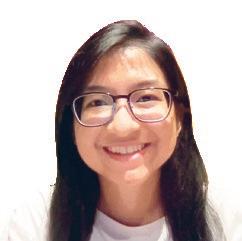
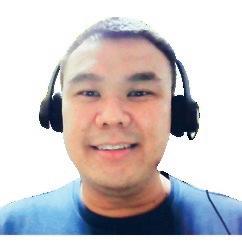
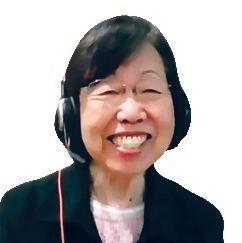
ZAIBUN: Seniors are often invisible. For example, in the recently released White Paper on Singapore Women’s Development, older women were not mentioned, let alone the issues and challenges they face. There has to be a change in the way of thinking, right from the ground. ALVIN: My general observation is that there is generally an ageist attitude, especially among younger Singaporeans. Children don’t lie, and if you ask them to draw an older adult, more often than not it would be a person on a wheelchair or with a walking stick. Yet the elderly are heterogenous. Policies try to take care of the 80 per cent but the other 20 per cent have varied needs and wants.
ZAIBUN: Ageism is everywhere, and we have to raise awareness to remove the stereotypes associated with persons of a certain age. It is the discrimination of persons by their age, and to see them as unworthy of attention and incapable of employment. Ageing is a natural process of life, just like childhood, and people need to recognise that. We need to bring in laws and policies to prohibit age discrimination, so we treat people fairly — in housing, employment, goods and services — regardless of their age.
OUR PANEL
MS ZAIBUN NISSA SIRAJ
SHARMA: It is a question of mindset. Instead of thinking of issues surrounding older people as a “problem”, put them at the centre of the conversation and ask what can be done for the people who may have contributed to the nation all their lives and have been an integral part of our society. The onus of caring for parents who cannot financially maintain themselves adequately is put on their children under the 1995 Maintenance of Parents Act, but what about old



Ageism is everywhere, and we have to raise awareness to remove the stereotypes associated with persons of a certain age.
MR DONALD WYATT (ARTS ’60), RETIRED; FOUNDING COMMITTEE MEMBER OF CHARITY FUNDRAISER NUS RAG & FLAG
MS CHAN MEE LEEN (SCIENCE ’70), RETIRED PRINCIPAL
MR SHARMA SUNDARESWARA (LAW ’85), ADJUNCT SENIOR LECTURER
MS ZAIBUN NISSA SIRAJ (ARTS ’68), TRAINER, MOTIVATIONAL SPEAKER AND AUTHOR
MR ALVIN CHUA (ARTS AND SOCIAL SCIENCES ’03), SOCIAL WORK INSTRUCTOR
MS LEE ZHENG FEN (SCIENCE ‘18), WORKS IN HEALTHCARE OUTREACH
MS GOH SHI CHUN (ARTS AND SOCIAL SCIENCES ‘18), MEDICAL SOCIAL
WORKER OUTREACH TEXT BY KOH YUEN LIN
According to a May 2021 survey of Singaporeans’ retirement knowledge and their engagement in the Central Provident Fund, 39%
of respondents did not feel confident they would have enough money for retirement. Singaporeans aged 35 to 44 accounted for the highest share of respondents in this regard.
Source: cdn.endowus.com/ press/EndowusSingapore-RetirementReport-2021.pdf
MR SHARMA SUNDARESWARA
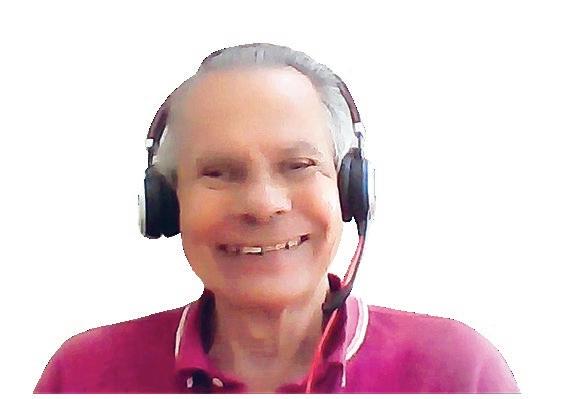

people without children? Next, beyond financial considerations, what those born before 1965 want are often time and attention. I encourage my boys, who are in their 20s, to visit their grandparents, who are in their 90s, while they are still around. The concern is not just about treasuring people while they are with us, but also about being more considerate of others’ needs. Our turn will come, to be in our seniors’ shoes. The big question is: How do we get more and younger people to commit more time to senior care, facilitate intergenerational conversations and nurture empathy? These all start with a change of mindset.
How can this mindset be changed?
MEE LEEN: As an educator, I believe many agencies and schools try to teach the children to show respect to seniors. Schools also offer community programmes that instil a sense of social responsibility and nurture empathy. However, because of curriculum requirements and other factors, these programmes are often organised during school breaks and after exams, rather than at a higher frequency. That said, education happens beyond schools, within homes. Family upbringing is an influence on a child’s mindset, and children look at how their own parents treat old people to form their opinion — and subsequently, how they treat their own parents in their old age too.
SHARMA: Educational institutions are uniquely placed to change the mindsets of the young because the students who come through their doors will be the leaders of tomorrow. If students can commit to spending time with older adults on a regular basis — planned as a sustainable, structured part of the curriculum — they can form their own understanding of ageing. It is not something that can be impressed upon through textbooks.
SHI CHUN: I remember initiatives at NUS, where students were invited to think about how the private sector can be creative in caregiving solutions for the elderly. I agree that education is critical in reframing the threatening “Silver Tsunami” into a “Silver Reservoir” full of potential.

ZHENG FEN: There were also modules that we took on population health. But beyond attending programmes and doing outreach, we need to approach elderly individuals with the right mindset. It’s not just about “us doing something for them”, but building two-way relationships. This, as Mee Leen pointed out, starts within families. As a young person, I’m mindful of how
I act because the next generation will model after me.
DONALD: The point is that the elderly want to feel like they are cared for by the community. That said, as a grassroots leader in my neighbouhood, I have experienced occasions when I was not welcome into a home even when I was trying to extend a helping hand. It can be challenging to reach out to marginalised elderly who are truly in need. It takes a lot of commitment and effort.
ZAIBUN: Loneliness and suicide are also key issues among old people — especially among older women. They tend to be caregivers who have given up work for their family, thus they might not be as employable and might have less accumulated income. Given that women live longer than men statistically, some might find it challenging to support themselves financially. With no work, they could also lose a sense of purpose, leading to mental and emotional instability.
SHI CHUN: In Asian societies, people are often shy to ask for help. But if we try to see the other party in a neutral light, simply as a person — rather than one in need of assistance — it will help them open up. It takes more than a one-time visit to gain their trust.
Given that the world is changing faster than ever, how can the aged keep up with the times? Or is there even a need to do that?
SHI CHUN: I would want to continue to upskill, adapt and keep up with the times even as I grow old, but I am respectful of every individual’s comfort zone. For example, my dad, who is a taxi driver, refuses to work with Grab because he does not like the notion of using GPS navigation. That has affected his income, but it is ultimately his decision. You need to strike a balance between respecting a person’s autonomy and helping them make informed decisions and respond to changes in the world. That said, the older adults I work with are very open to, and genuinely enjoy learning.
The onus of caring for parents who cannot financially maintain themselves adequately is put on their children under the 1995 Maintenance of Parents Act, but what about old people without children?
28 . THE ALUM NUS forum
ZAIBUN: My husband, who is much older than me, uses the computer and watches a lot of TV. But he does not use a mobile phone. People, especially young ones, are often shocked. But Shi Chun’s point is brilliant. There is a push for digitisation everywhere, and there are many programmes, services and schemes that old people are unaware of because they are not online. It is something that needs to be rethought.
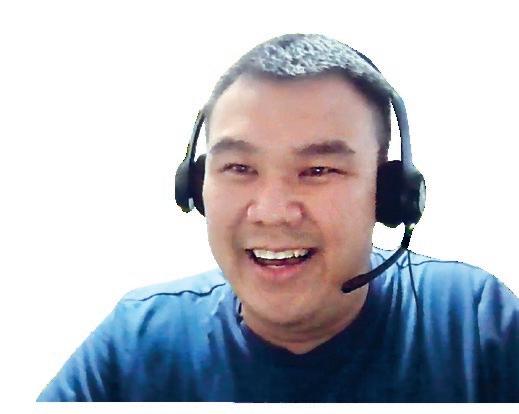
SHARMA: There is a lot of help out there but it is communicated mostly through digital channels, which might not reach the intended audience effectively. Rethinking communications can make a good job even better. The National Library Board’s outreach efforts, for instance — from targeted digital resources to large-print books — have been done very well and thought through thoroughly. Technology can unite, not divide, as long as it stems from a genuine care for others. There are gaps and cracks to fill, but I am optimistic we have capable talent to build a more cohesive society, despite the widening intergenerational differences in a rapidly changing world.
Established in the late 1990s, the Inter-Ministerial Committee on the Ageing Population (IMC) aimed to orchestrate a coordinated national response to the challenges of an ageing society.
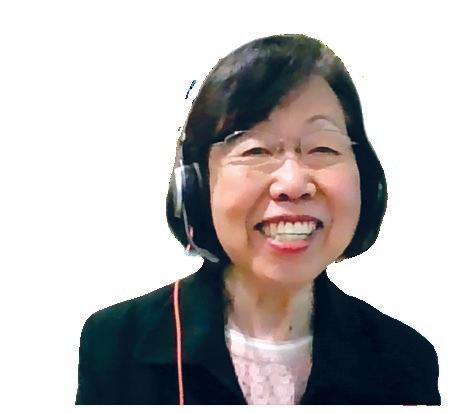
By 2004–2006, the Committee on Ageing Issues (CAI) was working towards enabling those who turn 65 by 2010 to maintain a high quality of life.
What are your hopes for your golden years?
MEE LEEN: My hope is simply that my nieces and nephews continue to care for me when I am immobile. I do find healthcare centres to be of high standards, and I have the confidence I will be well taken care of in this country. That said, when I retired (and no longer had employment benefits), it became very expensive to continue to stay with my specialist, which was important to me as I have a complicated heart condition. I felt I had been cast out of the system because I had stopped working. But I did not contribute less than anybody else! I am thankful for the environment that allows us to build up our assets, but I do wish our government can also listen to the hopes and fears of the older population, and make us feel more recognised. I hope we can value ourselves no matter what stage of life we are in — to never think of ourselves as useless. It might be good to help our youth think of seniors as a pool of wisdom. After all, we laid the foundation and created a structure for them to build upon.

SHARMA: Hopes and dreams evolve over time. I now hope for better engagement with friends and family, and those of different generations. I make it a point to build intergenerational bridges in what small ways I can. Regarding respect, care and love for our seniors, inspiration can be drawn from an old song which goes “you can’t hurry love, you’ll just have to wait, just trust in the good times, no matter how long it takes.” Seniors have much to offer even in old age, including patience and perseverance.
ZAIBUN: I want to carry on as I am. I want to be able to dance, write, speak, attend plays and concerts, entertain, interact... I want to be able to do all the things I can do, to always be able to jump into my car and go anywhere I wish.
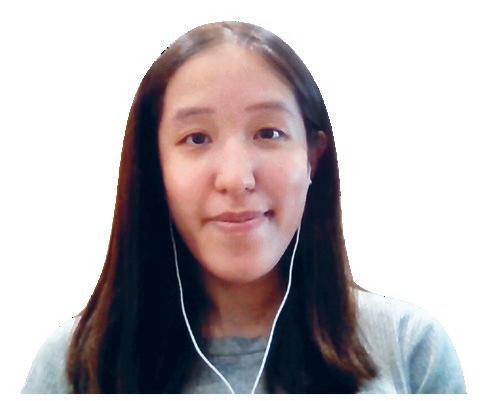
DONALD: I hope for a gracious society that treasures our citizens regardless of their age, and which keeps our people safe from problems.
write to us
If you’d like to join our Forum panel, do
at alumnihelpdesk@nus.edu.sg to express your interest.
You need to strike a balance between respecting a person’s autonomy and helping them make informed decisions and respond to changes in the world.
MS GOH SHI CHUN
OCT—DEC 2022 29
WHO THEY ARE
United by a shared passion for entrepreneurship and helping seniors, the three co-founders of HomePal are exploring the use of infrared technology to improve care for the elderly in nursing homes and private residences. The product is currently in development, and the team hopes it will hit the market in 2024.
Catching that Fall
How a new product by HomePal, a company set up by College of Design and Engineering alumni Mr Chen Hong Wei (’21), Mr Lai Hoi Bing (’21) and Mr Tan De Jun (’22), could protect seniors living alone.
AFALL IN ONE’S SENIOR YEARS CAN BE DEBILITATING ENOUGH. But its effects can be made worse if no one knows that you have fallen fallen until much later.
This issue is especially pressing in Singapore, where more than one in ten seniors live alone. To tackle this, three NUS alumni have brought together technology and a dash of sensitivity to create HomePal, a remote monitoring solution that also protects the privacy of seniors.
The system relies on a set of infrared sensors placed around the house. These detect the movement patterns of clients and the data is fed back to a machine learning system, which learns to identify the seniors’ usual patterns. Caregivers are then notified when patterns out of the ordinary are detected. Because it uses infrared technology and not video, HomePal sensors can be placed with confidence in private areas such as bathrooms,

pursuit of excellence
30 . THE ALUM NUS
HomePal’s founders (from left to right) Mr Lai Hoi Bing, Mr Tan De Jun and Mr Chen Hong Wei.
where falls tend to take place. “We don’t want to limit the movement of seniors or make them feel like they are being watched,” shares Mr Chen Hong Wei, one of HomePal’s three co-founders.
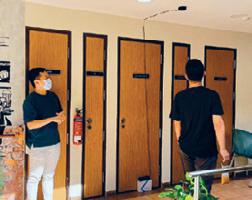
But why would three young students be so passionate about the welfare of seniors?
Mr Lai Hoi Bing, another co-founder of HomePal, points to their collective experiences. Mr Chen, 27, recalls a time when he felt ill and dizzy while alone at home. “At that moment, I was gripped by a panic of falling and without anyone knowing about it. If it was like that for me, can you imagine how seniors living alone might feel?” Being away from home also means that Mr Chen worries constantly about his parents, who are both in their 50s. Fellow co-founder Mr Tan De Jun, 25, also remembers how he came home one day to find his elderly neighbour’s domestic helper frantically looking for help. “My neighbour had fallen down and her helper could not lift her off the ground. Her helplessness and panic left a deep impression on me.” Mr Lai, 29, adds, “It’s not just our stories. We were struck by stories of seniors who had passed on in their homes without anybody knowing.”
Armed with this passion, the trio set out to create HomePal for a hackathon organised by the Housing and Development Board in 2020. Their passion and sensitive use of technology impressed the judges, and they have also garnered support from various entities, including NUS’ Resilience and Growth Inititative, the National Youth Council via its Youth Action Challenge, and the United Nations Delevopment Programme. With this, they have set out to develop HomePal further, hoping to transform it from a mere tech tool into a social enterprise that helps seniors live out their golden years more independently.
THE NEXT LEVEL
To develop HomePal further, the co-founders are in regular contact with nursing homes, who will likely be among HomePal’s biggest clients when it is eventually released. “Working with nursing homes means that the scope of the problem we’re trying to solve is much more defined, which will help as we are in the early stages of development,” explains Mr Chen, who looks at tech development for HomePal.
He likens the process of working with nursing homes to co-creating a solution: nursing home staff and resources are often stretched, so using tech like HomePal could help them improve their productivity. “But there are lots of
nuances and needs that we, as non-healthcare professionals, may not understand. So it’s important for us to speak to our partners regularly to get a sense of what they need before we can think of ways that tech can solve these issues.” HomePal’s product lead, Mr Lai, adds that the early relationships they foster with stakeholders in the eldercare space, such as nursing homes, will put them in good stead for further expansion. “If we can make our impact felt in nursing homes, we may be able to grow our business to reach out to customers who live alone.”
JOURNEYING TOGETHER
The trio is currently looking to grow more partnerships and hopes to launch HomePal in 2024. Helping them on this journey are the nine or so interns who Mr Tan, Mr Chen and Mr Lai passionately mentor. “Our entire team is highly capable, with strong technical perspectives and an ability to translate these to real-world solutions,” shares Mr Lai.
The core team of Mr Chen, Mr Lai and Mr Tan is driven by a close friendship that was forged at N-House, an entrepreneurship-themed residence managed by NUS Overseas Colleges and part of NUS Enterprise. Being part of the N-House community inspired each of them to become entrepreneurs in their own right — even though they had little thought of doing so before university. “There’s an air of entrepreneurship and innovation in N-House and it’s infectious,” reveals Mr Chen. “Even though we were all in the final years of university and weighed down by assignments and projects, we were inspired to embark on our entrepreneurial journey.” Adds Mr Tan, “There was a sense of gratitude for the year we had together at N-House, and the desire for something great to come out of the time spent there.” If the potential of HomePal is anything to go by, then it looks like they have done just that.
HOW HOMEPAL WORKS
Infrared sensors are placed around the house and feed data on movement patterns to a central dashboard.
Machine learning algorithms help the dashboard understand what a person’s normal movement patterns are.
Team members conducting an on-site trial at Jamiyah Nursing Home.
When a person strays from these normal patterns, a caregiver or loved one is alerted.
OCT—DEC 2022 31 TEXT BY ROY SIM
There’s an air of entrepreneurship and innovation in N-House and it’s infectious. Even though we were years of university and weighed down by assignments and projects, we were inspired to embark on our entrepreneurial journey.
With almost 40 years of experience in nearly every aspect of the law — from private practice and in-house counsel roles to time in academia — Adjunct Professor Ruby Lee is a familiar face in legal circles. She now focuses on helping law students discover the possibilities of pro bono work.
ADJUNCT PROFESSOR RUBY LEE HOLDS FIRM TO THE BELIEF THAT, AT ITS CORE, the law is a means to help people.

“Legal professionals can sometimes lose aim of this noble intention amid the hustle and bustle of practice,” she explains. But she hopes that through early and meaningful exposure to pro bono work, lawyers will keep sight of their purpose in a service vocation.
Adj Prof Lee knows a thing or two about how busy practice can be. She joined a private practice in the late 1980s, and the late Chief Justice Yong Pung How (Doctor of Laws ’01), was appointed in 1990. He was tasked to speed up the processing of cases in the courts. “I was doing a trial practically every week! It was tough work,” she recalls.
Perhaps it is this exposure to the daily grind that has shaped her approach to pro bono work, which broadly refers to legal service for vulnerable and less-fortunate groups that is provided free of charge.
“You have to do it when you are ready,” she advises budding lawyers. “For the first few years, they will be struggling at the law firm and adding that pro bono burden on them can be difficult. So I tell them to keep it at the back of their minds and to do it in bits and pieces. You don’t have to embrace it to
the point where it takes away from your daily work. Do a case here, do a case there... it’s a worthy start.”
These are some of the lessons she instils in students at the Singapore Management University’s Pro Bono Centre, where she is currently Deputy Director, and previously at the NUS’ Centre for Pro Bono and Clinical Legal Education, which she co-founded in 2015. Both centres aim to foster a pro bono culture among law students through various programmes.
CHAMPIONING THE COMMUNITY
Recalling the nascent days of the Centre, Adj Prof Lee recounts, “We went out into the community to find projects that would meaningfully engage students.” It was also important for these projects to be formalised, as the Singapore Institute of Legal Education requires all law students to complete 20 hours of pro bono work as part of their graduating requirements.
Among the early projects she initiated were public talks on matters like wills, probate matters and divorce. She saw these as valuable learning lessons for both
PUTTING THE “PRO” IN
the community and her law students. “My students were able to see the very real impact of the laws they study. They would hear from the public and be quizzed on the laws by them, so they learnt how to communicate these to the layperson.”
During her course of work, Adj Prof Lee also saw an opportunity to help parents and caregivers of children with intellectual disabilities. “These parents can be so consumed with the stress of caregiving that they fail to realise that when their charge turns 21, they can no longer do certain things for them, like access their bank account or sign consent forms on their behalf. That’s because the law recognises their children as being of age and thus, able to make such decisions.” Parents can apply for deputyship of their children to overcome
WHO SHE IS
How helps law students realise the value they can bring to the community.
32 . THE ALUM NUS changemaker
this legal hurdle, but it is a process that can cost up to $10,000.
“Those with the means are able to afford the hefty fee. But there are others who will struggle with the cost. I then saw this as an opportunity for my students to assist,” shares Adj Prof Lee. Under her supervision, law students would help parents navigate the legal process, assisting in areas like filing court documents and attending court hearings with them.
During her time at NUS, Adj Prof Lee and her team of students helped more

My students were able to see the very real impact of the laws they study [and] learnt how to communicate these to the layperson.
THE NEED TO HELP
Improving legal representation and access to justice are key goals of pro bono programmes. It is an important issue in Singapore, where more than 96% of applicants and 99% of respondents for maintenance and personal protection orders are unrepresented.
Source: Criminal Justice Club, an official sub-club under the Law Club of the National University of Singapore, Faculty of Law.
than 60 families save thousands of dollars in legal fees, while ensuring they could continue caring for their loved ones with intellectual disabilities. Adj Prof Lee ran this project to help various organisations, among them the Movement for the Intellectually Disabled of Singapore (MINDS), KK Hospital and the Down Syndrome Association.
FINDING HER LANE
The pro bono requirements for graduating students were only implemented in 2014 — more than two decades after Adj Prof Lee graduated. “So when we left school and thought about ‘helping the community’, it was restricted to activities like spending time with seniors in a nursing home.” Her work with the Centre for Pro Bono and Clinical Legal Education has inspired her to think about how else she can contribute to the community.
She eventually settled on being a Pro Bono Deputy, to be a proxy decision-maker for those without the mental capacity to do so. “(Singapore is) an ageing population and the government was worried about people who developed conditions like dementia, but who also had assets. This group of people would have trouble accessing their assets because of mental conditions.”
While professional deputies are remunerated for their work, Adj Prof Lee does it for free. It can be a thankless process, she reveals. “There are, for instance, bureaucratic hoops I need to jump through in order to fulfil my responsibilities as a deputy.” She shares about one case she handled for a woman in her 80s. “She had to be put in a nursing home and had no one to make financial decisions for her. Eventually, I decided to liquidate her assets and upgrade her to a top nursing home where she could get quality care.”
The phrase “liquidate assets” can be misleading — it doesn’t bring to mind the kind of heavy lifting that Adj Prof Lee engages in: from going into the flats of those she is caring for, to selling their belongings to karung guni (rag-and-bone) men, and even choosing the clothes they will be laid to rest in. “Someone’s got to do these things, so why not me?”
OCT—DEC 2022 33 TEXT BY
HETHER IT IS DISCUSSING
WTHE SHARING OF CHILDRAISING RESPONSIBILITIES, to overcoming predefined beauty standards for women, or looking at the multiple roles that men and women play in today’s society, it is important that we do not alienate men when engaging in discussions about gender equality.
These were some key takeaways at the Around the Tok Panjang chat, which was held at NUS Baba House on 13 August. The event was initiated by the Idea Co.’s GEN, a for-impact organisation that works to close the gender gap and bridge generational differences. To this end, it has launched a series of events with NUS Baba House that runs from August to December 2022. Named Around the Tok Panjang, the series aims to bring together community members and academics in Singapore to further understand and contextualise gender-related conversations within the Peranakan culture.
The 13 August event was moderated by TEDxSingapore’s lead curator and GEN’s co-founder, Ms Vivian Lim, and led by local writer Ms Josephine Chia, who has written widely about her Peranakan upbringing and kampong culture. Instead of researchers having dialogue sessions about what culture and gender mean, Ms Lim said she wanted to bring the community in and share their stories. She invited Ms Chia to discuss and dive deeper into how Peranakan women are depicted in her works and literature.
Having grown up in a kampong during the 1950s, Ms Chia kick-started the conversation by recounting how her mother, who was born into a Peranakan
family in Malacca, was a key influence in her life. “I felt that I owed her a lot because without her, I would not have been educated. Because during that period, education was mostly reserved for boys,” shared Ms Chia. And while studying in England — which was considered a privilege — she was told that her mother had developed Alzheimer’s disease.
“So I felt guilty about not looking after my mother, because I was away. And so I thought I would write a book to show how much I respected her,” she revealed. Ms Chia also documented her younger sister’s challenges in looking after her mother in one of her books. “My sister sometimes found it burdensome to have our mother in the home, and I do not blame her. She had to put up with a great deal on a daily basis and was the ‘quiet heroine’.”
Bridging the Gap through Dialogue
Through the lens of local writer , attendees at the Around the Tok Panjang chat on 13 August gained insights into gender-related issues within the Peranakan culture.
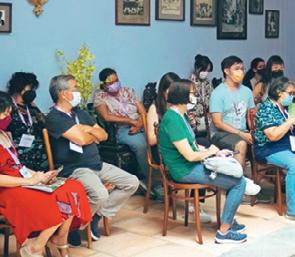

DEBUNKING CULTURAL AND GENDER STEREOTYPES
When Ms Lim asked Ms Chia if she was one of those “rich Peranakans”, she replied that she had to overcome the stereotype of all Peranakans being rich. Also, many people associate Peranakans with people of Chinese extraction, not realising that there are also Peranakan Arabs, Peranakan Dutch and Peranakan Indians. “A number of the Peranakan Chinese in Malacca and Singapore were merchants who established businesses in these places and so they did indeed become very wealthy. And much of the political eclogue in Singapore in the early days stemmed from those who were of mainly Peranakan descent — and this has led to the idea that a lot of Peranakans are very wealthy and influential,”
spotlight 34 . THE ALUM NUS
Photos courtesy of Idea Co.
Ms Chia explained. “When I used to meet some of the Peranakans at social events, I used to feel terrible because I was a ‘poor Peranakan’. Nobody heard of where we come from,” said Ms Chia. Interestingly, Ms Chia — who always sensed that her mother was different from the other kampong women — learnt that her mother used to play the violin and that she had come from a wealthy family.
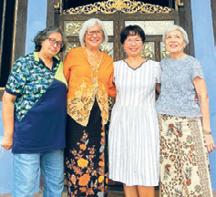
During the engaging 80-minute chat, Ms Chia, who incorporates social consciousness into her works, stressed that education makes a difference in how a woman becomes “somebody”. “Back then, a woman’s role was to be a breeder, and you just were supposed to have as many kids as possible. I would say almost 90 per cent of the women, when I was growing up in the 1950s and 1960s, were poor and didn’t have an education. It was only when the (People’s Action Party) came in that schools were set up and education was made compulsory — and this led to greater opportunities,” said Ms Chia. In her book Kampong Spirit, Ms Chia narrated the story of her best friend, Paradi, an Indian woman who never received an education. “My father used to wonder what the point of girls going to school was, because ‘you will poison your mind and you will have an opinion’. It was really tough. And I had to fight hard for my education,” shared Ms Chia.
Ms Chia also documented the feisty mother-in-law, who was the family’s matriarch and made life difficult for the daughter-in-law in her work, Mother-In-Law Son. That story resonated with many Merdeka Generation readers who wrote in to say they had the same experience. “It was easier for men back then, who worked to bring home the money and they gave their wives control over how the house was run. But once their own sons got married, these women actually turned on their own kind and would become the nasty, controlling mother in-law,” shared Ms Chia.
THE IMPORTANCE OF OPEN CONVERSATIONS BETWEEN THE GENDERS
During the Q&A session, Ms Chia also answered questions on gender equality and said women and men are co-dependent, and must learn how to reason with each other. “For example, a working woman who wants to have children will need to discuss with her husband on how they can share child-raising responsibilities,” said Ms Chia.
“As a Peranakan woman, it’s nice that we learn domestic skills sewing and cooking. But as we are also educated, we can now have an open discussion with men instead of fighting with them. For example, we can tell them that we need their help to change our kids’ diapers at night since we are also working,” Ms Chia added. She also answered a question on what a Peranakan woman should look like and why women need to be comfortable in their own skin.
“I’m Peranakan so I do not look like the fairskinned Chinese beauty typically depicted in our society. I’m tanned as I love the outdoors and I do sports like hiking,” she said. Finally, Ms Chia ended the conversation by saying that life and culture constantly evolve.
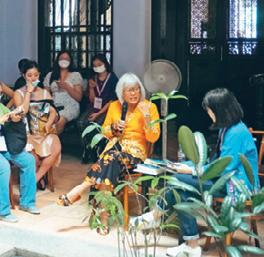
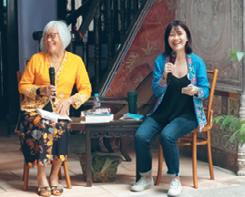
“For example, I might wear a Peranakan costume that’s made from a different material now instead of the traditional fabric, simply because it’s more comfortable. But a ‘purist’ Peranakan might frown upon that,” she said, adding that it was important to embrace change.
The session attracted academics and members of the public keen on exploring gender issues.
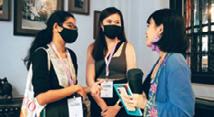
THE NEED TO BRIDGE GENDER INEQUALITY AND DISCRIMINATION
In 2021, 13 per cent of Singapore companies were helmed by a female CEO, and more women have taken on leadership roles. But women still face disadvantages, according to the White Paper on Singapore Women’s Development, which was debated in Parliament earlier this year.
From a societal standpoint, gender inequality is still a pertinent issue in Singapore.
In a study by Ipsos, 24 per cent of Singaporeans deny the existence of gender inequality and believe that feminism does more harm than good, and that feminism has resulted in men losing out in political, economic and social settings.
Gender discrimination in the workplace has also been a prevalent issue in Singapore. A survey by NTUC U Women and Family (U WAF) and People’s Action Party Women’s Wing (PAP WW)
found that 10 per cent of female respondents had experienced being passed over for promotion or career advancement due to their gender.
The latest data from YouGov Profiles indicates that gender equality in the workplace remains elusive, with seven in 10 women agreeing that men and women experience unequal treatment at work. And women in specific sectors, such as construction, healthcare and engineering, are more affected by gender disparity in the workforce.
Participants shared their views and exchanged insights during the chat.
TEXT BY AUDRINA GAN OCT—DEC 2022 35
PEOPLE MOVE ON
Professor Elaine Ho is a member of the NUS Department of Geography and the Asia Research Institute. Themes in her research agenda include immigration and citizenship, diaspora engagement and emotional geographies. While much of this research is centred on mainland China, she has also studied migration trends in Singapore, including its intersection with ageing.
THE REPUBLIC OF SINGAPORE WILL TURN 65 IN 2030, AND EVERY FOURTH PERSON YOU ENCOUNTER THEN AT YOUR KOPITIAM WILL BE THAT AGE, OR OLDER. In eight years’ time, the country will thus enter the ranks of ‘super-aged societies’, according to a DukeNUS study acknowledged by state officials. While that might conjure images of people in retirement homes, Professor Elaine Ho suggests otherwise. “The ‘young old’, like the Merdeka Generation, are very active (physically as well as socially) and have really embraced the government’s call for active ageing,” she says. “One senior in my research project had accumulated more than 20 certificates from using her Skills Future credits!” This, in her view, is a group of people who are clearly ready or preparing to take charge of their own destinies.
Currently, Prof Ho is engaged in no fewer than five research projects, mostly centred on ageing. Why is a geographer looking so intently at this issue? Prof Ho points out that ‘ageing in place’ — the formal term for living out our golden years in our own homes and neighbourhoods — is fundamentally about place; and ‘place’, of course, is something geographers specialise in.
AGEING, MIGRATION AND LONG-TERM CARE
While studying migration, Prof Ho’s project on the confluence between migration and ageing led her to dive deeper into the topic of ageing in Singapore. “In order to understand how our seniors experience ageing in Singapore as a migration hub, I needed a better grasp of longterm care and ageing policies in the country,” she explains. The project began in 2017, with the Lien Foundation coming onboard to ask for a review of the long-term care policy framework in Singapore. The resulting Care Where You Are report became part of a CNA documentary.
Singapore’s position as a migration hub allows Prof Ho to explore a multitude of subjects, including ageing. The topic of ageing did however, bring up questions about migration and how that ties in with long-term care in Singapore. Her research (Transnational Relations, Ageing and Care Ethics or TRACE)
Caring is Complicated
By 2030, 20 per cent or more of Singapore’s population will be aged 65 or above. Professor Elaine Ho Lynn-Ee (Arts and surveys this seismic demographic shift to see what the future might hold for elderly and their caregivers.
also revealed that seniors in Singapore were ageing alongside seniors from other countries, largely elderly from China acting as caregivers for their grandchildren here.
“Many of these grandparenting migrants are on short-term visas, but they attend neighbourhood activities alongside Singaporean seniors,” says Prof Ho. In some cases, they are not short-term visitors, as Prof Ho discovered while observing senior catwalk classes. The instructor was a former model from China who was taking care of her grandchildren, and had lived in Singapore for decades.
PRACTICAL IMPLICATIONS
Stories like this are more than merely colourful because they also illustrate some practical issues. For the grandparenting migrants in TRACE, their efforts can be considered social reproductive work, which allow the parents to continue working and contributing to the economic development of Singapore. Despite this, these grandparenting migrants are unable to access all the benefits Singapore offers to senior citizens, because they are neither citizens nor residents. Prof Ho also notes that these seniors are exposing
frontiers
36 . THE ALUM NUS
DISPARATE CIRCUMSTANCES
themselves to some risk, because they space out their healthcare appointments in their countries of origin. When asked, they say this is primarily due to cost issues, and is also the reason that these seniors often bring a large stockpile of medicines with them.
Of course, cost is also an issue that impacts local seniors, and Prof Ho’s Care Where You Are report illustrates this in stark terms. She keenly points out that long-term care is separate from healthcare, and there are challenges inherent in trying to understand these costs. It is also challenging to understand the subsidies in place to alleviate some of these costs.
AGENCY FOR THE ELDERLY
For the elderly who are frail and who live by themselves, Prof Ho advocates getting family members to be more involved when it comes to disseminating the wealth of information on programmes and options available. Workplaces, too, can play a part, principally in leave benefits to care for elderly family members. “Volunteers from Social Service Organisations are strapped for time and cannot do everything, so we have to mobilise all of society to help,” she says.
On the subject of how the elderly view their own prospects, Prof Ho’s work generally shows that they have more agency and more opportunities than ever before. “In a different generation, the elderly might have just sat at home and waited for their children to return or to visit — and that would be the highlight of their day. Today, the elderly do not just age in place, but form networks across their neighbourhoods, and across multiple neighbourhoods, as they travel for classes or to meet their friends.” This actually forms the basis of one of Prof Ho’s current research projects,
Ageing and Social Networks: Mapping the Life-worlds of Older Singaporeans
The subject of community care brings up the issue of caregivers once again, and it is an area that Prof Ho has done significant work in. She highlights a critical pay gap between care providers who deal with acute healthcare and those in the long-term care profession. While acknowledging the point that these are indeed two separate areas, Prof Ho notes that long-term care providers get the short end of the stick. The work is dirty and difficult, and the pay does not stack up.
SOLVING A FIRST-WORLD PROBLEM
Given that Singapore requires caregivers such as nursing aides, this is clearly a problem. Prof Ho also notes that it is indicative of a future problem, because some children quit their jobs to take care of their parents. They might burn through their own savings to such an extent that they will no longer be able to support themselves in old age. The solution might seem like migrant labour, but it is complicated. “As part of the TRACE project, we also went to Myanmar to interview trainees in the area of caring for the aged. They told us that Singapore is not their first choice as a migration destination; Japan and Hong Kong pay better. Canada allows them to eventually apply for permanent residency. So we’re competing globally, and the best may not choose to come (to Singapore).”
Community care is thus an option, although it is not without its own issues. “Increasingly, there’s this recognition that this is probably the better model, as domestic workers will not be able to provide that level of professional care.” ‘Community care’ is not another term for nursing homes. “What we are referring to is day care, rehabilitation and dementia care. These are daytime facilities rather than nursing homes where seniors stay in,” says Prof Ho. “Families are now more open towards community care.” She adds that this model allows the elderly to benefit from professional care while still being able to live with family. Nevertheless, funding issues remain.
In the report Care Where You Are, Prof Ho concludes that while Singapore has “a world-class acute care system and provides universal healthcare, the long-term care system remains relatively underdeveloped and underfunded.” Now that a few years have passed since the report’s release in 2018, Prof Ho is optimistic about new grants and schemes, and better training options for caregivers.
“We advocate an all-of-society approach — and this is where the geographer in me speaks.” She adds that exploring the topic of ageing in the school curriculum, in Social Studies classes for example, could equip children with information that may be relevant to their grandparents.
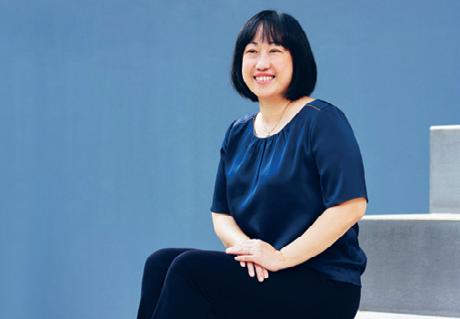
OCT—DEC 2022 37
TEXT
BY ASHOK SOMAN . PHOTO BY KELVIN CHIA
We advocate an allof-society approach [to tackle the issue of an ageing society] — and this is where the geographer in me speaks.
A 2018 Lien Foundation report found that office receptionists earn $1,000 more per month than nursing aides on average. Source: The Straits Times
CELEBRATING
Graduates from the Yong Siew Toh Conservatory of Music will help make The Esplanade’s 20th anniversary celebration an evening to remember.
T
HIS YEAR, THE ESPLANADE — THEATRES ON THE BAY CELEBRATES 20 YEARS OF BEING A PREMIER ARTS SPACE IN SINGAPORE.
Fittingly, the occasion will be marked by an unforgettable night of music: Illuminations, a one-night concert by the Singapore Symphony Orchestra (SSO), is a love letter to the venue from the arts community.

The show on 5 November will be a big night for graduates from the Yong Siew Toh Conservatory of Music (YSTCM) as well. Renowned conductor and YSTCM faculty Dr Lien Boon Hua (Music ’11) will lead the SSO for the first time, and under his charge are a number of prominent YSTCM alumni. Pianist Dr Abigail Sin (Music ’10) and violinist Mr Loh Jun Hong
(Music ’09) will kick off the night with a stirring rendition of Mendelssohn’s Concerto for Violin, Piano and Orchestra. Following their performance, the stage comes alive with a performance of Illuminations, an original composition by pianist Mr Jonathan Shin (Music ’15) and pipe organist Dr Phoon Yu (Music ’15). The piece was specially commissioned for the occasion and is inspired by the history, architecture and cultural significance of The Esplanade. The SSO will be joined onstage by the Singapore Symphony Chorus, Youth Choir and Children’s Choir for the performance.
The AlumNUS meets some of the performers to hear more about their musical journeys and reflections on their time in YSTCM.
AN EARLY EDUCATION
MR LOH JUN HONG, 32
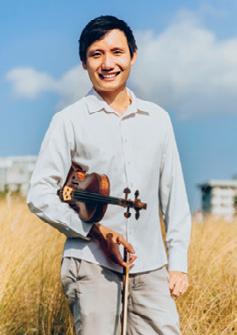

“I started playing the violin when I was seven. My older sister played the piano, so my parents wanted me to try something different. Eventually, they settled on a violin. I think I had a natural ease in picking up melodies and memorising them. Coupled with my competitive nature, that helped me improve quite quickly.
It was a big decision for me as a 15-year-old to leave Raffles Institution at Secondary Three to enrol in YSTCM. But I decided to do something that I loved and enjoyed, and I think it was the right decision. It was at the Conservatory that my love for music truly took off. I was exposed to the best of the best and experienced its ability to connect people and bring us together. From great classes to excellent concert experiences and much-needed exposure and opportunities to play in concerts, YSTCM helped me find my musical footing. My education also cemented great friendships, such as with Abigail, whom I will perform with at Illuminations. She has been a longtime chamber music partner but November will be the first time we perform a combined solo with an orchestra.
Whenever I play for an audience, I hope they will leave inspired and emotionally fulfilled. Music is in many ways a form of communication, just
special feature 38 . THE ALUM NUS
Mr Loh Jun Hong
Dr
Lien Boon HuaMr Jonathan Shin
like a story or movie. It draws on the great works of the past, combined with the interpretations of musicians in the present, to touch the audience’s hearts.”
MUST LISTEN: “Tchaikovsky is my favourite composer. His music is always theatrical and beautiful, and till this day, my number one violin concerto is Violin Concerto in D major, Op. 35 – the only concerto for violin he ever composed.”
TEACHERS PAVED THE WAY
DR ABIGAIL SIN, 30
How did you decide that you wanted to pursue music professionally? I had a slightly unusual educational trajectory. I entered YSTCM when I was only 14 years old and graduated at 18. I skipped the O-Levels and everything, but kind of overcompensated for that by getting a PhD. My parents have been very supportive throughout, though I am sure they did not know what we were getting into as they are not musicians.
Tell us about how your interest in music developed. I had great teachers who nurtured my curiosity. I remember listening to lots of recordings and being amazed at the kinds of sounds that these musicians were able to create, stirring up powerful emotions and telling fantastical stories. At YSTCM,
my teacher, Professor Thomas Hecht, gave me a technical and musical foundation that has formed the basis of everything that I do. My academic teachers helped me to realise that there are so many ways to explore and communicate music, and that my interests in performance and academics could complement each other.
What do you hope audiences will take away from your performance at Illuminations? The Mendelssohn double concerto is such a fun piece, and it was written when he was just a young teenager. It is a celebration of youth and life. I hope that sense of fun will be shared by the audience.

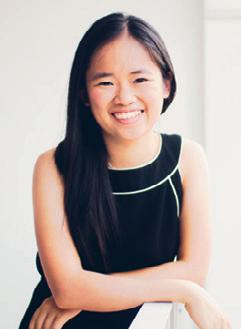
What advice do you have for others looking to make a splash in the music scene?
It is a really long journey and our “career path” probably will not be what we originally envisage. But there is so much to stay curious about and there’s a lifetime of growth ahead.
MUST LISTEN: “Ravel’s Gaspard de la Nuit performed by Martha Argerich. It’s a shimmering, volatile and utterly seductive sound-world that made me fall in love with the possibilities of the piano.”
A VOICE FOR THE ORGAN DR PHOON YU, 32
If there is one thing Dr Phoon Yu hopes the audience will pick up from his performance at Illuminations, it is a curiosity about the organ. “Better still, an inspiration to learn it — or get their kids to,” he quips. His own journey to the organ started relatively late when he was 20, but he has been playing the piano and the Chinese yangqin since he was a child.
“My interest in music developed quite organically from playing those two instruments and then listening to, and reading about classical music.”
This appreciation deepened during his time at YSTCM. “Being in YSTCM gave me access to a lot of resources, such as scores and books about music. I was also fortunate to gain
connections with other musicians and opportunities to compose and perform.”
It also led to a three-semester stint at the Peabody Institute of the Johns Hopkins University, the oldest conservatory in the United States.
Since then, he has completed his Doctor of Musical Arts degree in organ performance at The Juilliard School as a C. V. Starr Doctoral Fellow under the tutelage of Paul Jacobs. He will return to Singapore for Illuminations, which he co-wrote with fellow alumnus and friend Mr Jonathan Shin. Reflecting on the hard work of musicians, he says, “I think splashes don’t generally happen out of the blue; usually, people just keep working and improving at their craft until they get noticed by someone who can make things happen for them. It’s a slow-building process, although getting to know people (and getting people to know about you!) certainly can accelerate the process.”
MUST LISTEN: “Johann Sebastian
Bach’s ‘Gigue’ Fugue in G major BWV 577 as played by my teacher Paul Jacobs on the NPR Music Tiny Desk series: the combination of feet virtuosity, complex counterpoint, and quasi-orchestral registration sums up the pinnacle of organ-playing.”
Tickets for Illuminations are available at esplanade.com
OCT—DEC 2022 39 TEXT BY ROY SIM
Dr Abigail Sin
Dr Phoon Yu
Philosophy Party 2022
1 July 2022
On 1 July, NUS Philosophy Department held its first Philosophy Party since the COVID-19 pandemic struck. The party provided a chance for over 90 faculty members, recent graduates from the Classes of 2019, 2020 and 2021, and alumni to connect over dinner, games and great conversation.
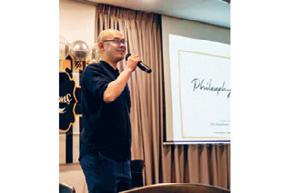
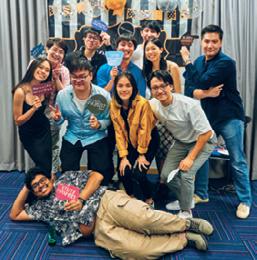
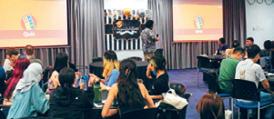
Reunion Lunch for EMBA Intake 29
Congratulations, EMBA Intake 29! This batch was the first cohort from NUS Business School to graduate during the COVID-19 pandemic. Despite a three-month delay to the start of their 15-month journey, the group soldiered on amid a volatile, uncertain, complex, ambiguous and hyperconnected (VUCAH) world. The class tackled relentless disruptions, embraced changes in the world order, integrated across boundaries, showed their mettle and beat the odds to finish their course.


Their grit, resilience, optimism and steadfast commitment to learning carried them through the most trying circumstances.
On 9 July, after the Commencement ceremony, some members of the class –comprising talented individuals from across 16 nationalities – gathered for a jubilant reunion lunch at the University Cultural Centre to celebrate their togetherness, relive precious memories, exchange updates and make vows of long-lasting friendships. Bravo NUS! Bravo Intake 29!
Other than the party, the Department also organised another dinner on 1 August to thank alumni for their contributions to their alma mater. As part of the PH4550 module on Internship: Philosophy for Teaching, the Department also partners pre-tertiary institutions in Singapore to provide undergraduates a teaching internship experience. Many stakeholders are Philosophy alumni, who continue to provide invaluable guidance and mentorship to undergraduates.
9 July 2022
ALUMNI HAPPENINGS EVENTS 40 . THE ALUM NUS
Participants posing for a group shot at the photobooth.
NUS Graduation Gala 2022.The EMBA Class of 2022.
Bonding over games, food and great conversation.
Address.
Helping Alumni and Singapore’s Workforce Meet the Demands

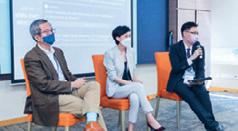
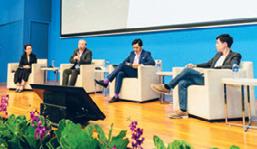
19 July 2022
Thank you for making NUS Lifelong Learning Festival 2022: FutureWork a roaring success! Organised by NUS School of Continuing and Lifelong Education (SCALE), the Festival was part of the ongoing SkillsFuture Singapore Festival, aimed at promoting and supporting lifelong learning as the future of work continues to evolve. The event was graced by more than 30 experts, industry leaders and academics, including Minister for Education Mr Chan Chun Sing. Out of over 1,000 participants, around 400 NUS alumni attended the event, which was held at the Shaw Foundation Alumni House.
To mark NUS’ commitment to supporting its alumni in their career advancement, transition and lifelong learning goals, the University announced a new alumni benefit: an automatic 15 per cent tuition fee rebate on more than 60 Masters by Coursework programmes which are not subsidised by the government.
On top of the tuition fee rebate, NUS also unveiled a refreshed Career+ mobile app, an AI-powered learning and career development tool designed exclusively for NUS students and over 330,000 alumni. The new enhancements help identify the relevant skills required for the user’s career aspirations, and match skills gaps to courses offered by various Institutes of Higher Learning.
News of these initiatives was well-received by NUS alumni.

The FutureWork Panel Discussion on what organisations must do to help our human capital ride on opportunities brought about by digitalisation and the green transition. From left to right: Professor Susanna Leong (Law ’89), Vice Provost (Master’s Programmes & Lifelong Education), and Dean (School of Continuing and Lifelong Education); Professor Fong Kok Yong (Medicine ’80), Deputy Group Chief Executive Officer (Medical and Clinical Services), SingHealth; Mr Dean Tong, Managing Director and Head, Group Human Resources, United Overseas Bank Limited; Mr Frank Koo (Business ’90), Head of Asia, Talent and Learning Solutions, LinkedIn
Ms Pavita Puansari (Design and Engineering ’22), an Operations Executive who recently graduated with a Bachelor of Technology in Industrial and Management Engineering, said, “With the tuition fee rebates, NUS has addressed a concern of many who intend to pursue postgraduate studies, myself included – the financial impact and potential return on investment in upgrading ourselves. These new initiatives are beneficial and will give many an extra push to pursue further studies.”
OCT—DEC 2022 41
NUS President Professor Tan Eng Chye delivering his opening address at NUS Lifelong Learning Festival.
Q&A during a masterclass on developing futureready healthcare professionals. Left to right: Associate Professor Lau Tang Ching (Medicine ’91), Associate Professor Zhou Wentao (Nursing ’09), and Associate Professor Chong Choon Seng (Medicine ’04) from NUS Yong Loo Lin School of Medicine.
Ms Susan Lee, Lecturer from the NUS Centre for English Language Communication, presenting a masterclass on future-proofing workplace communication skills.
27 July 2022and Welcome Dinner 2022
The Faculty of Dentistry (FoD) hosted its recent graduates from the Class of 2022 at a Commencement and Welcome Dinner, which was held at NUS Society’s Kent Ridge Guild House on Wednesday, 27 July. Graduates from the Bachelor of Dental Surgery, Master of Dental Surgery, Master of Science and PhD programmes attended the dinner. Acting Dean and Vice Dean (Academic Affairs), Associate Professor Wong Mun Loke (Dentistry ’99)
kickstarted the dinner with an opening address in which he congratulated the Class of 2022 and welcomed them to the FoD Alumni Family. Certificates were then presented to the Class Ambassadors by Associate Director of Alumni Relations, Dr Betty Mok (Dentistry ’81). Graduates enjoyed the rest of the evening bonding and catching up over a sumptuous buffet dinner as smiles and laughter filled the function room.


NUS Alumni Tokyo Chapter Gathering


29 July 2022
Three years after the COVID-19 pandemic, NUS Alumni Tokyo Chapter was finally able to hold an in-person gathering in Tokyo. Most participants who showed up were MBA graduates, while some were alumni from the Lee Kuan Yew School of Public Policy (LKYSPP), showing the depth and breadth of the NUS alumni network. During the gathering, each participant shared recent developments and discussed how they could assist in one another’s work and careers, and how they could contribute to Japan and its economy. The Chapter believes that the gathering was a good respite for all, and hopefully an inspirational experience for participants who were steadily developing their careers after graduating from NUS.
ALUMNI HAPPENINGS EVENTS 42 . THE ALUM NUS
Attendees of the first in-person gathering since the COVID-19 pandemic.
Singapore’s 57th National Day Celebration in Manila

Members of NUS Alumni Manila Chapter attended a reception hosted by the Singapore Embassy in Manila at the Grand Hyatt Ballroom in Bonifacio Global City, to celebrate Singapore’s 57th National Day. Around 25 alumni were present at this first major event that the Singapore Embassy in Manila has hosted since 2019. The alumni in attendance represented six faculties and schools, including the Faculty of Arts and Social Sciences, Faculty of Science,
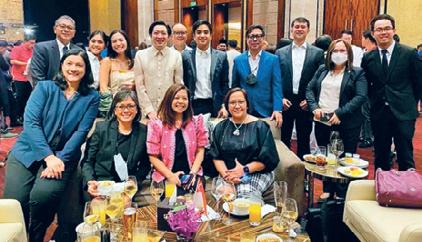
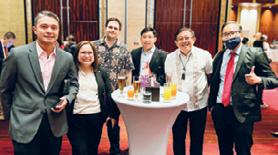
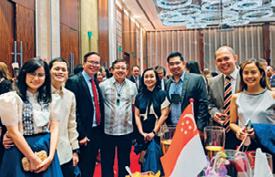
NUS Business, College of Design and Engineering, Lee Kuan Yew School of Public Policy (LKYSPP) and Faculty of Law. More than 800 guests, including government officials, the Diplomatic and Consular Corps, the business community, and Singaporeans in Manila, filled the ballroom to capacity.
The Guest of Honour for the event was Hon. Sara Duterte, Vice President of the Republic of the Philippines and the Secretary of the Department of Education. The formal
event started at 7pm, with a welcome remark by Vice President Duterte. She highlighted the importance of Singapore as a partner in developing the Philippines’ human resources through capacity-building programmes such as the Singapore Cooperation Programme, and expressed her hope that SingaporePhilippine relations will continue to flourish with increased cooperation in education and other related areas during the current administration. Ambassador Gerard Ho (Arts and Social Sciences ’97), who was also present at the event, noted the warm friendship between Singapore and the Philippines, and expressed his gratitude for the contributions of the Filipino community in Singapore during the COVID-19 pandemic. A buffet-style dinner featuring popular Singaporean food was served, including familiar dishes such as nasi lemak and Hainanese chicken rice. Guests stayed until about 10pm, enjoying both the food and the company.
OCT—DEC 2022 43 manila_alumni@u.nus.edu facebook.com/groups/2846267852110558/ 09 August 2022
A group photo of NUS alumni with Ambassador Gerard Ho.
Committee Members of NUS Alumni Manila Chapter.
LKYSPP alumni with Ambassador Gerard Ho.
NUS College’s Alumni Gathering on Kent Ridge


Pixel Art with Bricks Workshop

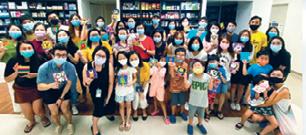
NUS College (NUSC) counts among its alumni graduates from the University Scholars Programme and Yale-NUS College. In support of Kent Ridge Alumni Family Day, members of the NUSC deanery, faculty and staff warmly welcomed these alumni back to campus for a cosy gathering and for them to learn more about the College. More than 120 alumni and their families attended the event, which was also accompanied by a tour of the Lee Kong Chian Natural History Museum led by Ms Julienne Tan (Chemistry ’12). At the gathering, Professor Philip Holden launched a Guided Autobiography course for alumni to reflect on milestones and memories – a good practice to adopt, given people’s fast-paced lives.
It was important for the new College to still be able to extend alumni services and benefits, including opportunities for interactions with various groups in the community. In her welcome
remarks, Vice Dean (Outreach) Prof Quek Su Ying thanked the many alumni who had stepped forward to conduct admissions interviews. Faculty members who attended the gathering, including Associate Professor Barbara Ryan (Affiliate Alumnus ’19), Associate Professor Low Boon Chuan (Affiliate Alumnus ’19), Dr Leung Wing Sze, Ms Anne Yeo (Arts and Social Sciences ’88) and Ms Tan Sin Yee (Arts and Social Sciences ’11) were happy to see alumni doing well in both their careers and with their families. The College was also heartened to hear that the alumni were keen to pay it forward by offering their assistance in areas such as internships, career advice and more.
The gathering concluded with how alumni could expect to be kept updated about the exciting start for NUSC. Associate Professor Kang Hway Chuan (Affiliate Alumnus ’19), who will be taking on a new role as Master of West Wing residences, also encouraged alumni to stay connected and reminded them that they are always welcome to drop by and say hello.
nuscollege.nus.edu.sg
Thank you to the ‘Pharmily’ members who attended the Department of Pharmacy’s Pixel Art with Bricks workshop on Saturday, 13 August, in conjunction with this year’s Kent Ridge Alumni Family Day! It was a splendid afternoon spent with Pharmacy alumni and their family members. Kudos to all for creating their own beautiful pixel art within the short space of an hour, and the department hopes that everyone made wonderful memories at this year’s annual homecoming event!
workshop was conducted by fellow alumnus Mr Jeffrey Kong (Arts and Social Sciences ’03) from Artisan Bricks.
ALUMNI HAPPENINGS EVENTS 44 . THE ALUM NUS 13 August 2022
The
pharmacy.nus.edu.sg pharmacy_alumni@nus.edu.sg facebook.com/NUSPharmacyDept instagram.com/nuspharmacydept 13 August 2022
facebook.com/nuscollege instagram.com/nuscollege
A Time for Celebration!
Since 2020, NUS Alumni Sing-Along (ASA) has celebrated National Day online over Zoom due to the COVID-19 pandemic. Alone in their homes or with a few invited friends, members sang along with the song leader while muted on Zoom.
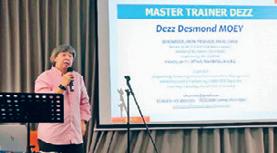

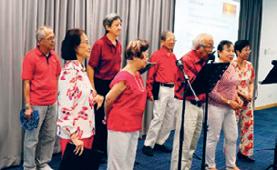
On Monday, 15 August, ASA members all decked out in red and white were able to celebrate National Day on-site at the Shaw Foundation Alumni House. The guest speaker for the day, Mr Desmond Moey (Engineering ’84), more commonly known as Dezz, Managing Director of Serendip Showbiz Pte Ltd and Board Member of Musical Theatre Ltd, an Arts Charity with IP status; kicked off the celebration with a talk on Why Write Songs?. As a songwriter, show producer and
vocal coach, Dezz highlighted different reasons why people write songs – for entertainment or to express one’s feelings, values and beliefs. In addition, he highlighted how songs could be structured, and how with different series of notes, chord patterns or musical phrases, songs could grab the listener’s attention. For example, the “hook” – a repetitive musical phrase which captures our attention – was often said to be what makes a song popular. Needless to say, Dezz was also able to “hook” the attention of the audience, leaving them hungry for knowledge on music creation.
Following the talk, ASA members led the sing-along by belting out local national favourites such as ‘Home’, ‘Count on Me Singapore’, ‘Stand Up for Singapore’, ‘Bunga Sayang’, ‘Voices of the Heart ( )’ and many more. The ASA Ukulele Group andMr Desmond Moey, more commonly known as Dezz.

members also gave their renditions of the evergreens and pop songs like ‘My Way’, ‘The Young Ones’ and ‘Una Paloma Blanca’, while the audience sang their hearts out to these upbeat tunes.
For the first time since the pandemic, refreshments were also served on-site. And what would a birthday celebration be without a birthday cake? To the delight of everyone present, Mrs Jenny Gan-Kwa Siew Eng (Arts and Social Sciences ’96) wheeled in the cake to celebrate the occasion. The celebration rounded off with everyone getting on their feet doing a line dance to the song ‘Y.M.C.A.’.
ASA’s next sing along session will be the Christmas Celebration Concert in December, and they look forward to welcoming members to join them in closing 2022.
The AlumNUS thanks all contributors for the articles and photos in Alumni Happenings, showcasing our vibrant alumni community. For the full stories, please visit nus.edu.sg/alumnet/TheAlumNUS/issue-131/community/alumni-happenings. OCT—DEC 2022 45 15 August 2022
A performance by The Evergreens.
A performance by the ASA Ukelele Group.
Ending the celebration with a line dance to the tunes of ‘Y.M.C.A.’.
NUS
PRIVÉ GRILL

LEE KONG CHIAN NATURAL HISTORY MUSEUM

NUS MUSEUM

off
NUS



for NUS Museum guided tour of
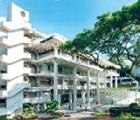
persons per group
to
Price:
All NUS
special
FOOD AND BEVERAGE

ALLIANCE COFFEE

SHAW
AFFORDABLE WINES

Schott
conditions
Office of Alumni
and participating merchants reserve the
the
and conditions governing the
prior notice.
information is
CALLING ALL BUSINESS OWNERS
We welcome alumni business owners to come on board as our merchant partners. Submit an

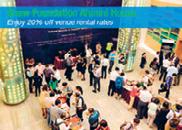
at bit.ly/NUSmerchants
offer special perks to your fellow alumni.
KETOMEI
RYAN’S GROCERY (S) PTE
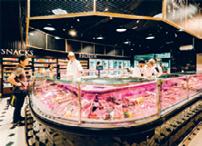
PRIVILEGES ON CAMPUS
• 15% off à la carte bill. privegrill.com.sg
• 10% off single-entry tickets, Individual and Family memberships. lkcnhm.nus.edu.sg
LIBRARIES Complimentary entry to all NUS Libraries upon presenting the AlumNUS card. • Annual subscription fee at $139.10 (Usual Price: $353.19). libportal.nus.edu.sg
• 20%
all
Museum’s publications and catalogues. • $20
up
20
(Usual
$50). museum.nus.edu.sg
FOUNDATION ALUMNI HOUSE • 20% off venue rental. nus.edu.sg/alumnet
alumni get to enjoy
deals at these popular retail outlets and service providers, and more! Visit Alum NET for more details and the full list of participating merchants.
application
and
Terms &
apply. NUS
Relations
right to amend
terms
offers without
All
correct at press time.
• 10% discount on coffee cart packages. • 20% storewide discount. Just use the code “NUSCommunity” at checkout. alliancecofee.net
• 10% off for purchases of $5,000 and above. • 10% off Zieher Wine Glasses, decanters and accessories. • 5% off Event Classic Wines. • 5% off Riedel Wine Glasses and Decanters. • Free Set of 6
Zwiesel Banquet Series Bordeaux Wine Glasses, with every $350 nett purchase of Chateau Carignan Wines. affordablewines.com.sg
LTD • 10% off with minimum spending of $20 for butchery. • 5% off with minimum spending of $10 for others. • 10% off total food bill (excluding beverage). ryansgrocery.com
• 20% off all meal plans. ketomei.com DOPO TEATRO • 20% off total food bill (with minimum spend of $80). dopoteatro.com.sg
HEALTH & BEAUTY
FARRER PARK HOSPITAL
• 24-HR Emergency Clinic services for NUS alumni. farrerpark.com

IMAGO ASTHETICS
• Medical Laser $58 Nett or Carbon peel laser $88 + 7% GST. imagoaesthetic.com.sg

LIFESTYLE
FLOWER ADVISOR
• 15% off for all items with discount code: NUS2022. floweradvisor.com.sg


LA VIDA
• Eyelash Lift + Eyebrow Shaping and Design at $38.

• Korean Eyeliner + Classic Embroidery at $298.
• BB Watershine Glow + Eyebrow Shaping and Design at $58. lavida.com.sg
ATOS WELLNESS
• Experience one of these at $48 (excluding GST) with experienced therapists or masseuses at Atos Wellness:
o Executive Aroma Facial (worth $180).
o Stress Busting Relaxing Body Massage (worth $180).

o Electronic Lymphatic Drainage (worth $180). atoswellness.com.sg
STORHUB
• Enjoy special discounts on storage fees and complimentary one-time transportation service, depending on the package. storhub.com.sg

PUREHYBRIDZ
• 10% off only the following Purehybridz services: Saltwater Masterclass, Freshwater Masterclass, Kayak Fishing Lessons.
• $4 off Purehybridz fishing setup (Usual Price: $59, includes rod, reel and line). purehybridz.company.site

HEBELOFT
• $3 off with minimum spend of $10 for all NUS alumni, staff and students using the code HEBETHREE upon checkout. hebeloft.com

EDUCATION
INTUNE MUSIC PTE LTD

• 10% off regular course fees (1st year of enrolment).
• $20 waiver off registration. intunemusic.com.sg
THE JOMU CO
• 10% discount off the total bill. thejomuco.com
TRAPPED ESCAPE ROOM
• $5 per pax with min. 4 paying guests trapped.sg
CELINE COOKIEMONSTERS ART

• 10% off all workshops and classes. ccmonstersart.com
WORLD SCIENTIFIC

• 25% off all purchases with discount code: WSNUS25 worldscientific.com
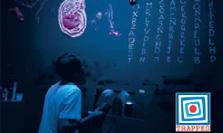
BANKING
ON DOING
GOOD
From trailblazer in the banking world to leader in social services — Ms Junie Foo (Arts and Social Sciences ‘90) has found her journey to be full of fulfilment.
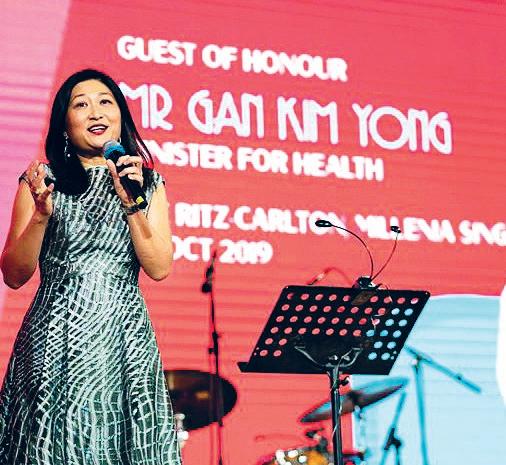
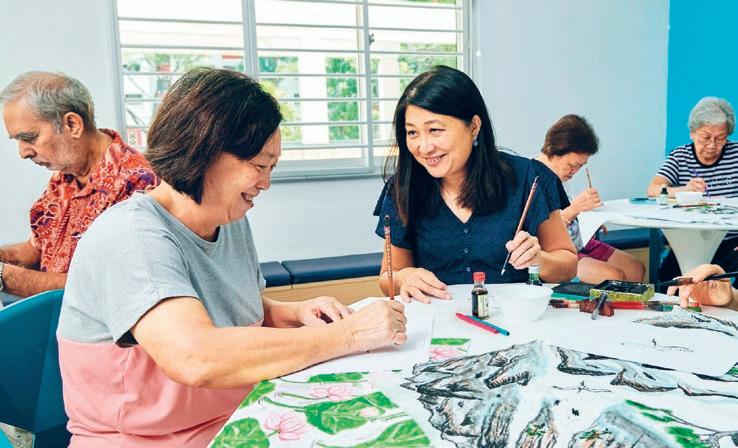
YOU COULD CALL IT AN ESSAY-WRITING ASSIGNMENT
THAT CHANGED HER LIFE. In 1990, Ms Junie Foo was a Political Science undergraduate when she entered a Japanese essay-writing competition. The topic? The past, present and future of Singapore. “I don’t remember exactly what I wrote, but I think we had been coming out of a recession at that point, so I touched on that, as well as on our multicultural society,” she recalls.
Her piece caught the eye of business leaders and, even before graduation, she was offered a job at a major Japanese financial institution. That kick-started her success in the financial industry, where, over the course of nearly 30 years, she attained many firsts. For instance, the distinction of being the first non-Japanese and the first woman in the management team of the Corporate Banking Division, Asia Oceania, in a Japanese financial institution.
But climbing the corporate ladder was not all that it was made out to be. “After 25 years or so, I recall doing the budgeting for our regions, looking at revenues and earnings, and thinking, ‘I can do much more for the community’,” she shares. She spent two years pondering her next move even as other banks came calling. Her husband, whom she had confided in, told
Above: Ms Foo chatting with a senior at the MWS Active Ageing Centre at Kebun Baru. Right: On stage at the MWS Charity Ball in October 2019.
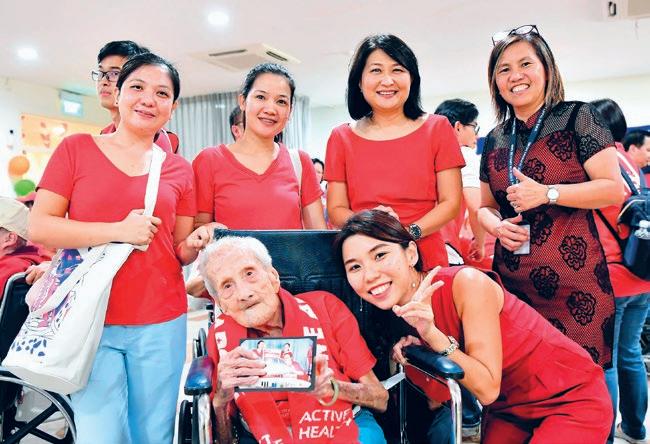

A DIFFERENT WORLD
her going back to the banks would be an act of “vanity”. “So I decided to do an act for the community,” she says, explaining her decision to join Methodist Welfare Services (MWS) as its Chief Executive Officer in 2018.
FINDING FULFILMENT
Ms Foo’s advice to those who are grappling with tough career choices: “Consider how fulfilling your new role might be. It is an overlooked factor, but one that can make all the difference.”
The world of social services was a far cry from the glamour of banking. As a multifaceted social services agency with over 600 staff, MWS’ operations span from helping the destitute to caring for vulnerable seniors in the community. Ms Foo quips that her career change took her from the glitzy restaurants of Marina Bay to rental flats in Hougang. “There was once I was at a nursing home and sitting with a resident who had been born blind and deaf, and had just been abandoned,” she recalls. “We could not converse at all, but I just sat next to her and put my hand on her shoulder to let her know that she was not alone.” Ms Foo describes it as a “moment of affirmation”. “It made clear that me being in social services was a calling.”
But she admits that, as with every sector, the social services industry too, has its challenges – the biggest being talent retention. Ms Foo’s former world of banking is rife with fat pay cheques, but such large salaries are impossibly rare in social services. “It says a lot about society and what we value,” says Ms Foo with a shrug. “But I’m hoping to change that. We cannot shortchange our talent, because they do so much good for the community.”
path less travelled
Ms Foo with staff and volunteers at a Chinese New Year celebration.
Painting with seniors at the MWS Active Ageing Centre.
48 . THE ALUM NUS

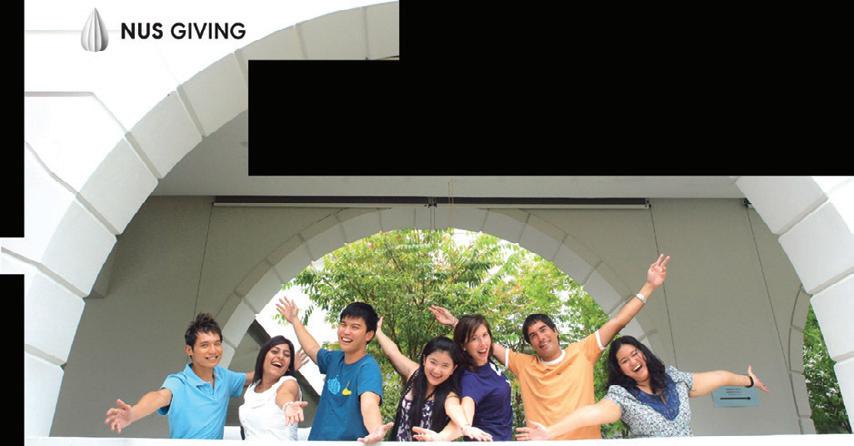

Do you know an alumnus who should be recognised for her or his outstanding achievements? Nominations open on 1 January 2023. Visit nus.edu.sg/alumnet/AlumniAwards to see past recipients. NOMINATIONS OPEN 1 JANUARY 2023 The NUS Alumni Awards celebrate and honour alumni who have distinguished themselves through significant and impactful contributions to their alma mater, society and the world. Nominees are alumni who have: • Distinguished themselves in their chosen fields • Rendered excellent volunteer service to NUS and/or the community




















 Participants enjoyed fun and games at the carnival held after the walk.
The volunteers paired up with children from needy families and accompanied them at the carnival.
The volunteers made sure that everyone — both young and old — was able to participate in the walk.
Participants enjoyed fun and games at the carnival held after the walk.
The volunteers paired up with children from needy families and accompanied them at the carnival.
The volunteers made sure that everyone — both young and old — was able to participate in the walk.















 NUS Cares is officially launched.
Prof Tan congratulated Sheares Hall and Yong Siew Toh Conservatory of Music on their 40th and 20th anniversaries respectively.
Participants trying their hand at various activities presented by clubs and societies at the Student Life Fair.
Prof Tan and Mr Bernard Toh (Architecture ’84), Director of NUS Alumni Relations, at one of the booths set up at UTown.
NUS Cares is officially launched.
Prof Tan congratulated Sheares Hall and Yong Siew Toh Conservatory of Music on their 40th and 20th anniversaries respectively.
Participants trying their hand at various activities presented by clubs and societies at the Student Life Fair.
Prof Tan and Mr Bernard Toh (Architecture ’84), Director of NUS Alumni Relations, at one of the booths set up at UTown.






























































 TEXT BY WANDA TAN
TEXT BY WANDA TAN
















































































































































